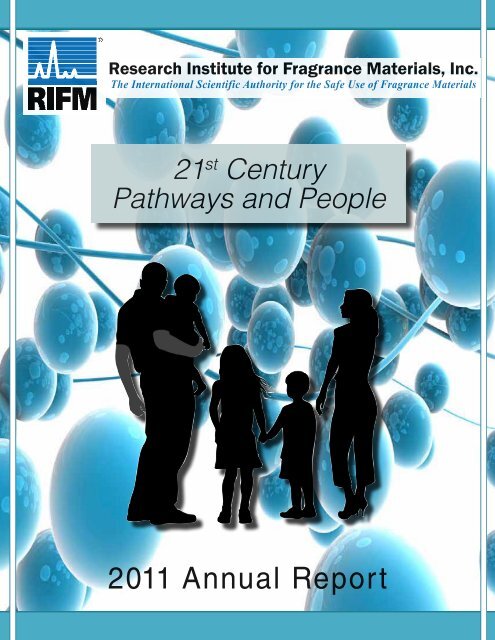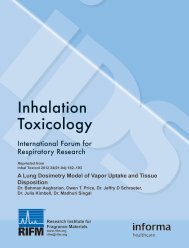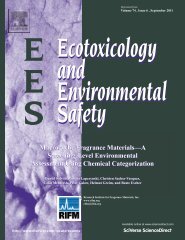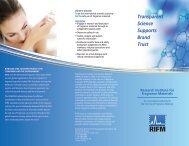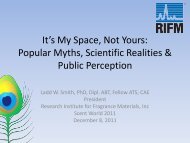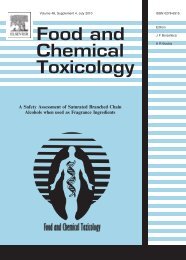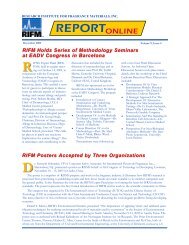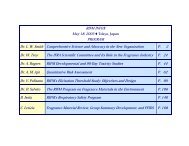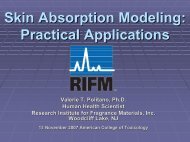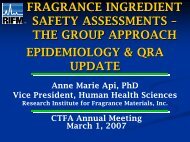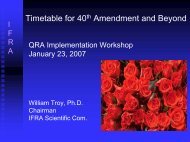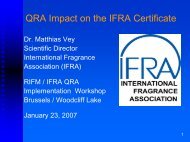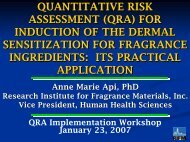2011 RIFM Annual Report - Research Institute for Fragrance Materials
2011 RIFM Annual Report - Research Institute for Fragrance Materials
2011 RIFM Annual Report - Research Institute for Fragrance Materials
Create successful ePaper yourself
Turn your PDF publications into a flip-book with our unique Google optimized e-Paper software.
<strong>Research</strong> <strong>Institute</strong> <strong>for</strong> <strong>Fragrance</strong> <strong>Materials</strong>, Inc.<br />
The International Scientific Authority <strong>for</strong> the Safe Use of <strong>Fragrance</strong> <strong>Materials</strong><br />
21 st Century<br />
Pathways and People<br />
<strong>2011</strong> <strong>Annual</strong> <strong>Report</strong>
2 21st Century Pathways and People www.rifm.org rifm@rifm.org
VISION<br />
To be the International Scientific Authority <strong>for</strong> the Safe Use of <strong>Fragrance</strong> <strong>Materials</strong><br />
MISSION<br />
• Engage in research and evaluation of fragrance materials through an<br />
independent Expert Panel<br />
• Determine safety in use<br />
• Gather, analyze and publish scientific in<strong>for</strong>mation<br />
• Distribute scientific data and safety assessment judgments to<br />
<strong>RIFM</strong> members, industry associations and other interested parties<br />
• Maintain an active dialogue with official international agencies<br />
www.rifm.org rifm@rifm.org<br />
<strong>2011</strong> <strong>Annual</strong> <strong>Report</strong><br />
1
Table of Contents<br />
21st Century Pathways and People<br />
<strong>2011</strong> <strong>Annual</strong> <strong>Report</strong><br />
Vision - Mission 1<br />
Letter From the <strong>RIFM</strong> Board Chair 4<br />
Letter From <strong>RIFM</strong>’s President 6<br />
<strong>RIFM</strong>’s Board Of Directors 8<br />
<strong>RIFM</strong>’s 45th <strong>Annual</strong> Meeting 9<br />
News From The Expert Panel 10<br />
Human Health Science 14<br />
Environmental Science 20<br />
Respiratory Science 24<br />
The <strong>RIFM</strong> Database 26<br />
<strong>RIFM</strong> Communications 28<br />
Member Services 29<br />
The <strong>RIFM</strong> Staff 30<br />
<strong>RIFM</strong>’s Member List 32
Message From the <strong>RIFM</strong> Board Chair<br />
It has been an honor and a privilege to have served you as Chair of<br />
<strong>RIFM</strong>’s Board of Directors this past year. I would like to update you on the<br />
state of <strong>RIFM</strong> and offer a glimpse of the challenges facing us.<br />
One of the primary responsibilities of the Board is governance. <strong>RIFM</strong><br />
is in excellent shape financially thanks to the support, even in these<br />
difficult economic times, of its member companies. With a recent clean<br />
opinion from its auditors, <strong>RIFM</strong> fulfills its commitment, through the<br />
interaction and guidance of the Expert Panel, to ensure the integrity of<br />
the science produced at <strong>RIFM</strong> and to maintain the level of transparency<br />
its membership and the global community has come to expect. The<br />
safety program is, after all, its whole reason <strong>for</strong> being.<br />
<strong>RIFM</strong> continues to publish research results in the open, peer reviewed<br />
literature. In the period between 2007 and 2010, <strong>RIFM</strong> had three of the<br />
most cited papers in the leading Journal, Food and Chemical Toxicology.<br />
<strong>RIFM</strong> works closely with Industry to identify emerging issues <strong>for</strong> proactive research. New programs in respiratory<br />
science and recent alternative methodologies <strong>for</strong> fragrance ingredient risk assessment are but a few of the<br />
projects underway. This authority underlies <strong>RIFM</strong>’s reputation as the place to go <strong>for</strong> the most comprehensive<br />
and current research on fragrance safety. The pages of this annual report are testament to the progress in<br />
excellent science <strong>RIFM</strong> carries <strong>for</strong>ward from its 46 year history of sound scientific research.<br />
Of course there are always challenges which come to us at an ever-increasing pace. Un<strong>for</strong>tunately, the<br />
significant progress we have made is not fast enough <strong>for</strong> our critics. Going <strong>for</strong>ward we will need to address<br />
these criticisms head on. We have a dual need of even more urgency <strong>for</strong> our testing program, while ensuring<br />
the thoroughness and credibility of the science itself.<br />
There are approximately 2,700 fragrance materials used worldwide, with 1,700 of these ingredients used at<br />
The exact cost <strong>for</strong> this ambitious program is still being determined but as you would expect, the price tag<br />
will be substantial and we must all share the cost.<br />
The IFRA Board – the fragrance companies that support a large part of <strong>RIFM</strong>’s and IFRA’s activities – has<br />
agreed to begin such a program. It will be robust, and will allow <strong>RIFM</strong> staff to obtain the necessary data/<br />
in<strong>for</strong>mation <strong>for</strong> the Expert Panel to complete and publish its safety evaluations. It is intended that this new<br />
ef<strong>for</strong>t also will communicate more directly with the public. The message: The fragrance industry is serious<br />
about its responsibilities and will continue to ensure the safe enjoyment of fragrances by millions of<br />
consumers around the world every day.<br />
I would like to publicly acknowledge the <strong>RIFM</strong> staff, the many industry volunteers and <strong>RIFM</strong>’s member<br />
companies who generously make their expert staff available <strong>for</strong> the benefit of the whole industry and<br />
society.<br />
I would also like to recognize the <strong>RIFM</strong> Board of Directors, and Executive Committee, who have been<br />
so dedicated in their roles and committed to <strong>RIFM</strong>. The breadth of representation in our Board meeting<br />
continues to result in a truly rich input that enables a very high quality discussion. I would like to thank<br />
the Board <strong>for</strong> this engagement and their support of me in my role – it has certainly made my job easier.<br />
Thank you.<br />
Sean G. Traynor, Ph.D.<br />
Chair, <strong>RIFM</strong> Board<br />
President, Takasago International Corp. (USA)<br />
www.rifm.org rifm@rifm.org<br />
<strong>2011</strong> <strong>Annual</strong> <strong>Report</strong><br />
5
Letter From The President<br />
Ladies and Gentlemen of the Membership,<br />
<strong>RIFM</strong>’s <strong>2011</strong> per<strong>for</strong>mance is best reflected in some highlights from my<br />
State of the <strong>Institute</strong> address, delivered at the 45th <strong>Annual</strong> Meeting of<br />
the membership on November 3rd. The largest attendance in our history,<br />
and the fact that we dedicated our program theme to Alternative<br />
Methodology, stand in testament to our ongoing evolution.<br />
• Our annual budget is approaching $10 million and provides testing,<br />
research and technical expertise from the staff and Expert<br />
Panel. In <strong>2011</strong>, we closed the year at a board-approved slight<br />
deficit. Operations costs reflected legal fees and software upgrades.<br />
Science expenditures were influenced by technical workshops<br />
and staff activity. Most of the deficit came from testing and<br />
research to accelerate respiratory work and use level support.<br />
• Our reserve fund is a healthy $3.5 million and will support future<br />
accelerated testing, while a baseline will be maintained <strong>for</strong> extraordinary<br />
situations.<br />
• Total membership, currently at 77 companies (47 Active, 6 IFRA<br />
Active, 5 Consumer Active, 16 Supporting, 2 Associate), has remained<br />
very stable over the last decade despite industry consolidation<br />
and global economic turmoil.<br />
• Expert Panel activities continue to address priority ingredient issues, long term testing strategy and<br />
publication of peer-reviewed scientific evaluations. Implementation of guidelines <strong>for</strong> tenure and rotation<br />
provide <strong>for</strong> relevant expertise and new thinking. Next additions will include chemistry and reproduction<br />
practitioners.<br />
• <strong>RIFM</strong> peer-reviewed publications – individual test results, respiratory deposition modeling, environmental<br />
group analyses and human health group summaries – continue to strengthen our scientific<br />
credibility.<br />
• Our postdoctoral training program is in its 4th successful year, having placed 3 well-educated and<br />
further experienced individuals within member companies.<br />
• Our business now is conducted through an online store, so members and other customers can have<br />
access to our educational and technical events, and we can accept electronic payment.<br />
• We have a social media presence and function in an international news arena. <strong>RIFM</strong>’s communications<br />
on LinkedIn, Facebook and Twitter will continue to be an important source of in<strong>for</strong>mation in an increasingly<br />
connected world.<br />
• A state-of-the-science epidemiology study will be reported in 2012 to finally address the true prevalence<br />
of fragrance allergy in the general population.<br />
• The first environmental group summary was published.<br />
6 21st Century Pathways and People www.rifm.org rifm@rifm.org
• Our respiratory program has developed and published novel methods to accurately evaluate inhalation<br />
exposure, related to important societal questions.<br />
• All our scientific programs integrate predictive, alternative and traditional methodology to supplement<br />
available data <strong>for</strong> a comprehensive safety evaluation.<br />
• Our flavor and fragrance database continues to expand its safety data and regulatory content and<br />
refine its usability, to provide unique member value and non-dues revenue through data sales <strong>for</strong> regulatory<br />
compliance. Features include state-of-the-art server technology, off site backup and expanded<br />
access.<br />
The highest current priority is development and implementation of an accelerated program to ensure adequate<br />
safety support of individual fragrance ingredients. This will involve a concerted ef<strong>for</strong>t, throughout the<br />
supply chain, to assess what we know, and to create a systematic approach <strong>for</strong> filling needs through all applicable<br />
methods. The greater challenge is to balance competing influences – to maintain the programmatic<br />
inertia that exists, to continue research, to increase testing – using transparent processes consistent with the<br />
goal of consumer protection.<br />
Other accomplishments over the last 14 years have addressed not only the scientific needs of the organization,<br />
but also the requirements of operating a global business. A few of these are: development of a Comprehensive<br />
<strong>Research</strong> Plan with a 5-year outlook and use of a Strategic Advisory Group to vet priorities and<br />
identify emerging issues; redesign of the Corporate logo and development of branding as the international<br />
scientific authority <strong>for</strong> safe use of fragrance ingredients; initiation of a robust communication program with annual<br />
reports, an updated website and use of press releases <strong>for</strong> widespread in<strong>for</strong>mation sharing; self-analysis<br />
of board governance practices, member services and company satisfaction; installation of association management<br />
software to create administrative efficiencies; development of best practices <strong>for</strong> fulfillment of tax<br />
requirements and fiduciary responsibilities; global recognition of <strong>RIFM</strong> staff professional expertise. Looking<br />
back on the opportunities I have had <strong>for</strong> mentorship, the last point is particularly meaningful to me.<br />
As I retire from my position as President in 2012, I want to express my gratitude to all those I have encountered<br />
and with whom I have had the pleasure to work. There is a lot of passion in this industry, which should<br />
serve it well in the future, as product life cycles mature, new markets develop and sustainable organizations<br />
are created.<br />
Best regards,<br />
Ladd W. Smith, PhD, Dipl ABT, Fellow ATS, CAE<br />
President<br />
<strong>Research</strong> <strong>Institute</strong> <strong>for</strong> <strong>Fragrance</strong> <strong>Materials</strong>, Inc. (<strong>RIFM</strong>)<br />
www.rifm.org rifm@rifm.org<br />
<strong>2011</strong> <strong>Annual</strong> <strong>Report</strong><br />
7
The <strong>RIFM</strong> Board of Directors<br />
Executive Committee<br />
Sean G. Traynor, Ph.D. (Chair)<br />
President<br />
Takasago International Corp.<br />
USA<br />
Robert H. Bedoukian, Ph.D.<br />
(Vice Chair)<br />
President<br />
Bedoukian <strong>Research</strong>, Inc.<br />
David C. Shipman (Treasurer)<br />
Group Vice President<br />
Firmenich<br />
Stephen Hicks (Secretary)<br />
Director, R&D<br />
The Procter & Gamble Company<br />
Michael Carlos<br />
President - <strong>Fragrance</strong> Division<br />
Givaudan Corporation<br />
Ladd W. Smith, Ph.D., Dipl.<br />
ABT, Fellow ATS, CAE (Staff<br />
Liaison)<br />
President<br />
<strong>RIFM</strong><br />
The <strong>RIFM</strong> Board meets 3 times per year and at this time<br />
has two subcommittees, the <strong>RIFM</strong> Executive Committee<br />
and the Strategic Advisory Group which works on strategic<br />
governance to maximize the efficiency of <strong>RIFM</strong>’s<br />
technical areas, Human Health, Respiratory, and Environmental<br />
Sciences and the <strong>RIFM</strong> Technical Database.<br />
The Board consists of 18 voting members representing<br />
13 fragrance ingredient manufacturers and 5 consumer<br />
product companies, all of which are <strong>RIFM</strong> Active<br />
members. There are also 5 non-voting, liaison members<br />
from the International <strong>Fragrance</strong> Association (IFRA), the<br />
Japanese Flavor & <strong>Fragrance</strong> Manufacturers Association<br />
(JFFMA), and the International <strong>Fragrance</strong> Association<br />
North America (IFRANA).<br />
Directors<br />
George Daher, Ph.D.<br />
V. P., Global Safety Assess. & Reg. Affairs<br />
S.C. Johnson & Son, Inc.<br />
Achim Daub<br />
Global Pres. Scent & Care,<br />
Exec. Board Symrise AG<br />
Symrise AG<br />
Rob J. M. Edelman<br />
V. P., Global BU <strong>Fragrance</strong> Ingredients<br />
International Flavors & <strong>Fragrance</strong>s, Inc.<br />
Isabelle Esser<br />
Vice President<br />
Deodorants R&D<br />
Unilever<br />
James Heinz<br />
President & CEO<br />
Bell Flavor and <strong>Fragrance</strong>s, Inc.<br />
Antoine Housset<br />
Deputy CEO Corporate Affairs<br />
Chanel SA<br />
Peter N. Lombardo<br />
President<br />
Robertet, Inc.<br />
Stephen R. Manheimer<br />
Executive Vice President<br />
Kerry Ingredients & Flavours, Inc.<br />
Miguel Pena<br />
Vice President, Aroma Chemicals<br />
BASF SE<br />
Richard C. Pisano, Sr.<br />
Executive Chairman<br />
Citrus & Allied Essences<br />
Viny Srinivasan, Ph.D., Dipl. ABT<br />
Asst. Vice P.resident<br />
L’Oreal<br />
Steve Tanner<br />
President/CEO<br />
Arylessence, Inc.<br />
Non-Voting Liaison Members<br />
Pierre Sivac, President<br />
IFRA<br />
Yoshinari Niimura<br />
JFFMA<br />
Jennifer Abril, Executive Director<br />
Kim Bleimann, President<br />
IFRANA<br />
Kevin Renskers, Ph.D<br />
IFRA Scientific Committee Chair<br />
8 21st Century Pathways and People www.rifm.org rifm@rifm.org
<strong>RIFM</strong>’s 45th <strong>Annual</strong> Meeting<br />
<strong>RIFM</strong>’s 45th <strong>Annual</strong> Meeting highlighted the development of technology <strong>for</strong> Alternative Methods of testing materials that<br />
is taking place in the scientific community, the fragrance industry and at <strong>RIFM</strong>. The theme of the <strong>2011</strong> <strong>Annual</strong> Meeting<br />
and <strong>Report</strong>, “21st Century Pathways and People,” was derived from the National Academy of Science publication, Toxicity<br />
Testing in the 21st Century: A Vision and A Strategy which can be viewed from the National Academy Press website<br />
at www.nap.edu.<br />
The publication was a project of the National <strong>Research</strong> Council, whose members are drawn from the councils of the<br />
National Academy of Sciences, the National Academy of Engineering, and the <strong>Institute</strong> of Medicine. The members of<br />
the committee responsible <strong>for</strong> the report were chosen <strong>for</strong> their special competencies and with regard <strong>for</strong> appropriate<br />
balance. The project was supported by the National Academy of Sciences and the U.S. Environmental Protection Agency.<br />
<strong>RIFM</strong> was <strong>for</strong>tunate to have as speakers, two of the authors of Toxicity Testing in the 21st Century.<br />
Daniel Krewski, MHA, MSc., PhD<br />
Daniel Krewski, MHA, MSc., PhD., Scientific Director<br />
of the McLaughlin Centre <strong>for</strong> Population Health Risk<br />
Assessment at the University of Ottawa and Martin L.<br />
Stephens, PhD., Vice President and Senior <strong>Research</strong><br />
Associate at Johns Hopkins University Center <strong>for</strong><br />
Alternatives to Animal Testing (CAAT). Both spoke<br />
about different facets of 21st century shift in technology<br />
from the animal model to the human model and<br />
how it affects toxicity testing and human health risk<br />
assessment and safety.<br />
Martin L. Stephens, PhD.<br />
Rounding out the speakers <strong>for</strong> the day was Jean-<br />
Roch Meunier, PhD., International Director of the<br />
Department of Predictive Biological Models and<br />
Methods at L’Oreal who gave the industry presentation<br />
on the development of an integrative approach<br />
<strong>for</strong> toxicity testing.<br />
Jean-Roch Meunier, PhD.<br />
The Expo<br />
This year <strong>RIFM</strong> expanded the annual meeting to include an exposition designed to allow <strong>RIFM</strong> staff to<br />
demonstrate and in<strong>for</strong>m meeting attendees about the alternative methods and models <strong>for</strong> fragrance<br />
material risk assessment in progress at <strong>RIFM</strong>. The demos and all presentation from the <strong>RIFM</strong> 45th <strong>Annual</strong> Meeting are<br />
available, <strong>for</strong> members, from the <strong>RIFM</strong> web site in the Member Events Archive<br />
www.rifm.org rifm@rifm.org<br />
<strong>2011</strong> <strong>Annual</strong> <strong>Report</strong><br />
9
<strong>Report</strong> From The Expert Panel<br />
The Expert Panel continues its tenure/rotation schedule. The complete roster of scientists participating on the independent<br />
panel is listed here. Other scientific experts, who participate as adjuncts, supplement the Expert Panel’s knowledge base.<br />
Items at each panel meeting include Conflict of Interest declaration, human health and environmental group summaries<br />
and fragrance material reviews, IFRA use level testing and Standards approval, priority materials resulting from PBT evaluations<br />
and human health and environmental criteria documents and risk assessments, the Comprehensive <strong>Research</strong> Plan,<br />
impact of REACH and systemic, dermal and environmental decision trees. The Expert Panel meets three times per year.<br />
The Expert Panel<br />
Dr. I. Glenn Sipes, PhD. (Chair)<br />
Professor & Department Head<br />
Department of Pharmacology,<br />
College of Medicine<br />
University of Arizona<br />
Tucson, AZ USA<br />
Prof. Donald V. Belsito, MD<br />
Clinical Professor, Medicine<br />
Department of Dermatology<br />
Columbia University Medical Center<br />
New York, NY USA<br />
Dr. David R. Bickers, MD (Co-Chair)<br />
Carl Truman Nelson Prof. & Chair<br />
Department of Dermatology<br />
Columbia University Medical Center<br />
New York, NY USA<br />
Prof. Magnus Bruze, MD - Professor<br />
Department of Occupational &<br />
Environmental Dermatology<br />
Malmo University Hospital<br />
Malmo, Sweden<br />
<strong>Research</strong> Prof. Peter Calow, PhD<br />
Science and Public Policy<br />
Office of <strong>Research</strong> and Economic<br />
Development<br />
University of Nebraska<br />
Lincoln, NE<br />
Prof. Maria L. Z. Dagli, DVM, PhD.<br />
Professor, Veterinary Pathologist<br />
Department of Pathology<br />
School of Veterinary Medicine and<br />
Animal Science<br />
University of Sao Paulo<br />
Sao Paulo, Brazil<br />
Prof. Dr. Wolfgang Dekant<br />
Institut fuer Toxikologie<br />
Universitaet Wuerzburg<br />
Wuerzburg, Germany<br />
Prof. Allison D. Fryer, PhD<br />
Prof. of Pulmonary and Critical Care<br />
Oregon Health & Science University<br />
Portland, OR USA<br />
Dr. Yoshiki Miyachi, MD, PhD<br />
Professor & Chairman, Dermatology<br />
Graduate School of Medicine<br />
Kyoto University Hospital<br />
Kyoto, Japan<br />
Prof. Jean-Hilaire Saurat, MD<br />
Professor & Chairman, Dermatology<br />
Swiss Center <strong>for</strong> Applied Human<br />
Toxicology<br />
University of Geneva<br />
Geneva, Switzerland<br />
Reproduction Advisory Panel<br />
Dr. Jochen Buschmann<br />
Head of Reproductive Toxicology<br />
Working Group<br />
Fraunhofer Inst. of Toxicology and<br />
Experimental Medicine<br />
Hannover, Germany<br />
Dr. Anthony Scialli<br />
Consultant<br />
Tetra Tech Sciences<br />
Arlington, VA USA<br />
Dr. Mineo Yasuda - Emeritus Professor<br />
Hiroshima University<br />
Sendai, Japan<br />
Environmental Adjunct Group<br />
Prof. Beate Escher<br />
Deputy Director<br />
National <strong>Research</strong> Centre <strong>for</strong><br />
Environmental Toxicology (Entox)<br />
University of Queensland<br />
Coopers Plains, Queensland Australia<br />
Prof. Michael J. Whelan, Ph.D.<br />
Sr. Lecturer in Environmental Science<br />
Dept. of Natural Resources<br />
Cranfield University<br />
Bed<strong>for</strong>dshire, United Kingdom<br />
Genetic Toxicity Adjunct Group<br />
Experts from the Neuherberg <strong>Institute</strong><br />
<strong>for</strong> Toxicology,<br />
Germany<br />
via Dr. Helmut Greim<br />
10 21st Century Pathways and People www.rifm.org rifm@rifm.org
The Expert Panel’s January meeting, held in<br />
Miami, Florida included a presentation by Dr. Wolfgang<br />
Dekant, University of Wurzburg, Germany, on some of<br />
his academic work with the toxicokinetics of 4-MBC, a<br />
material used in sunscreens. Dr. Dekant, a member of<br />
the Scientific Committee on Health and Environmental<br />
Risks (SCHER) committee in the EU, was invited<br />
to join the panel as a standing member. Dr. Helmut<br />
Greim rotated off the group, according to established<br />
operating guidelines. Other guests included a journalism<br />
student, Mr. Pierre Sivac, IFRA President, and Mr.<br />
Michel Bongi, IFRA Board Chair.<br />
Occupational Exposure<br />
The Panel continued its discussion of relevant<br />
occupational exposure, defined as the professional<br />
use of fragrance in settings such as hospitals, beauty<br />
salons and department stores. Evaluations of Finn and<br />
Hilltop patch test chambers were planned, to resolve<br />
false positive reactions seen in some phototoxicity assays.<br />
Results and plans from the Data Analysis and<br />
Priorities Group (DAPG) <strong>for</strong> accelerating the testing<br />
program were reviewed.<br />
Respiratory Program <strong>Report</strong>s<br />
Respiratory Program reports detailed endpoints,<br />
deposited dose, in the upper airways and lungs and<br />
wall mass flux (tissue absorption) <strong>for</strong> a variety of materials<br />
such as <strong>for</strong>maldehyde (control), acrolein (control)<br />
and acetaldehyde, as part of the Dosimetry/Deposition<br />
Computational Modeling Project. Corroboration<br />
studies have been completed with d-limonene, α-hexyl<br />
cinnamaldehyde, and isoeugenol showing little to no<br />
effect following 14 days of inhalation exposure. An<br />
alternative method in development that evaluates<br />
cytokine profiling was shown to be successfully<br />
feasible. Preliminary studies showed acceptable<br />
cell viability, intact cell junctions, and consistent cellular<br />
behavioral characteristics. Dendritic cell maturation,<br />
needed <strong>for</strong> sensitization, was shown to be<br />
independent of macrophage ratio and, as expected,<br />
dependent on signaling from both macrophages and<br />
epithelial cells. All 3 cell-types comprise the actual<br />
air-exchange unit in the lungs. A joint <strong>RIFM</strong>/member<br />
company proposal was submitted to the CEFIC Long<br />
Range Initiative Program <strong>for</strong> Inhalation Toxicological<br />
Threshold of Concern (TTC). The proposal was not<br />
funded due to the greater experience of the Fraunhofer<br />
<strong>Institute</strong> who ultimately received the award. <strong>RIFM</strong><br />
entered into a data sharing agreement with the<br />
Fraunhofer <strong>Institute</strong> to continue active participation in<br />
this project.<br />
IFRA<br />
IFRA business included actions on sensitization<br />
data <strong>for</strong> p-methoxybenzaldehyde, cyclamen aldehyde,<br />
vanillin, vanillin isobutyrate, alpha-butylcinnamaldehyde,<br />
ortho-methoxycinnamaldehyde, 2-heptylidene<br />
cyclopentan-1-one, 3-methyl-2-(pentyloxy)-2-cyclopenten-1-one,<br />
1-(2,4,4,5,5-pentamethyl-1-cyclopenten-1-yl)ethan-1-one,<br />
2,6,6-trimethylcyclohex-1,3-dienyl<br />
methanol and isoeugenol.<br />
Reproduction Workshop<br />
A reproduction toxicity workshop was held following<br />
the Panel meeting, with invited guests<br />
from the Expert Panel, the Reproduction Advisory<br />
Group, the IFRA Scientific Committee and member<br />
companies, as well as external experts.<br />
Key points included:<br />
• In vitro metabolism should use rat, rabbit and<br />
human cells<br />
• The current enhanced OECD 415 in vivo protocol<br />
was further modified to a significant degree—as<br />
a benchmark study <strong>for</strong> a material which would<br />
support a structural group<br />
• Dietary administration was selected, with the<br />
desire <strong>for</strong> kinetic studies, skin absorption and<br />
consideration of<br />
microencapsulation<br />
to avoid high/<br />
bolus doses<br />
• Hazard/toxicity<br />
studies are preferred<br />
vs. safety<br />
studies, although<br />
CMR and other<br />
labeling issues<br />
arise from studies<br />
which show adverse<br />
effects<br />
www.rifm.org rifm@rifm.org<br />
<strong>2011</strong> <strong>Annual</strong> <strong>Report</strong><br />
11
<strong>Report</strong> From The Expert Panel<br />
In May <strong>2011</strong>, the Expert Panel met in Brussels,<br />
Belgium, following cancellation of the planned<br />
trip to Tokyo due to the un<strong>for</strong>tunate natural events<br />
which occurred there. DAPG status was reviewed,<br />
notably the decision to retain responsibility <strong>for</strong><br />
functional ingredients, the content of the 11-endpoint<br />
Safety Dossier and company interest in supporting<br />
certain aroma chemicals. Occupational exposure was<br />
defined as “professional consumer” use, such as hair<br />
salons and similar consumer-oriented work spaces.<br />
Data from one company’s survey of 300 hair salons<br />
was reviewed.<br />
EDEN<br />
The EDEN epidemiology study was reported by<br />
Dr. Thomas Diepgen, one of the principal investigators.<br />
All people had been recruited <strong>for</strong> the 6<br />
European clinics; 10,000 had been interviewed<br />
and 2500 had been patch tested. Dr. Hans Merk<br />
also presented his expertise on proteins and<br />
metabolism, and the relevancy of understanding the<br />
proper dose and route of administration, such as<br />
the ability of a parent molecule to stimulate its own<br />
activation. Dr. Matthias Vey, IFRA Scientific Director,<br />
presented the results of an IFRA Scientific Committee<br />
workshop on IFRA Standards. The panel also heard<br />
a presentation by a non-member company on its<br />
reproduction/developmental testing with terpineol <strong>for</strong><br />
REACH compliance.<br />
Group Summaries<br />
Group summaries on the following structural classes<br />
were reviewed: alkyl cyclic ketones, para-alkyl phenols<br />
and aromatic hydrocarbons. Many of these included<br />
functional ingredients and materials which will be<br />
supported largely by companies. Group human health<br />
testing considerations included studies on: benzyl acetone<br />
subchronic, comparative in vitro metabolism,<br />
isobornyl acetate reproduction, p-methoxybenzaldehyde<br />
reproduction, alpha-hexyl cinnamic aldehyde<br />
skin absorption/metabolism, epoxides dermal sensitization,<br />
allyl ester dermal sensitization, alkyl cyclic<br />
alcohols dermal sensitization, and p-methylanisole<br />
reproduction.<br />
Environmental Strategy<br />
The Panel discussed an environmental strategy<br />
document which had been developed by the IFRA<br />
Environmental Task Force. The first environmental group<br />
summary on macrocyclic materials and 2 other papers<br />
were accepted <strong>for</strong> publication. Member company<br />
in<strong>for</strong>mation was requested <strong>for</strong> a planned life cycle<br />
assessment project to look at the environmental<br />
impact of manufacturing processes. Customer<br />
companies also have asked <strong>for</strong> hazard assessment<br />
of naturals. The panel discussed the role of socioeconomic<br />
analysis in environmental risk assessment<br />
in light of a recent ECETOC Task Force report<br />
stewarded by Peter Calow.<br />
Following the panel meeting,<br />
an INFOX was held in<br />
Brussels, continuing the<br />
tradition of sharing <strong>RIFM</strong><br />
research and providing<br />
an opportunity <strong>for</strong> scientific<br />
networking. In addition to staff discussion of<br />
human health, environmental and respiratory programs,<br />
this year’s session included<br />
• Presentations on the data accumulation program:<br />
• Chemical regulations in Japan and Asia<br />
• The role of pathology in safety<br />
evaluations<br />
• Relevant mechanisms in<br />
airway hyper-reactivity<br />
and asthma<br />
• An update on IFRA<br />
Standards and the<br />
compliance program<br />
As part of the INFOX,<br />
a special session on<br />
alternatives to animal<br />
testing addressed cellbased<br />
assays, sensitization<br />
methods research,<br />
Cosmetics Europe’s strategy<br />
<strong>for</strong> skin sensitization and<br />
development of peptide<br />
reactivity assays.<br />
12 21st Century Pathways and People www.rifm.org rifm@rifm.org
In September, the panel met in Barcelona, Spain,<br />
where, as last year, the European Society of Contact<br />
Dermatitis provided an ancillary learning opportunity.<br />
Dr. Helmut Greim provided a primer on mixture<br />
toxicity, covering the opinion of DG Sanco’s 3 scientific<br />
committees. Notably the opinion recommends:<br />
additivity should be assumed <strong>for</strong> components with<br />
similar modes of action, TTC and QSAR are appropriate<br />
methodologies, and <strong>for</strong> ecotoxicology, the use of<br />
Predicted No-Effect Concentration is <strong>for</strong> protection of<br />
populations and not individuals.<br />
In<strong>for</strong>mation on the DAPG/accelerated program was<br />
reviewed, using the plan presented to the <strong>RIFM</strong><br />
Strategic Advisory Group. A positive outcome of<br />
low priority analysis may be a reduced fragrance<br />
palette, which perhaps would enable the industry to<br />
better support remaining ingredients. One potential<br />
issue might be differing safety evaluations, if providers<br />
are responsible <strong>for</strong> their individual materials. The<br />
panel also developed a plan to handle the additional<br />
workload which would be created by increasing the<br />
amount of data to be reviewed, and made allowance<br />
<strong>for</strong> extra time to be spent in 2012.<br />
Professor Bruze presented on elicitation and induction<br />
and relevance of a positive patch test to true<br />
allergy. <strong>RIFM</strong> has received much credit from the<br />
European dermatology community <strong>for</strong> supporting<br />
Dr. Ann Therese Karlberg’s work on oxidation. The<br />
group summary on alkyl cyclic ketones was agreed.<br />
Group testing items included terpineol reproduction,<br />
acetoxydihydrodicyclopentadione subchronic,<br />
10-undecenal subchronic, lauric aldehyde subchronic,<br />
p-methoxybenzaldehyde reproduction and<br />
methyl anthranilate developmental. Use level testing<br />
discussions involved ethyl maltol phototoxicity,<br />
Tagete phototoxicity and Sandalwood oil photoallergenic<br />
potential.<br />
The computational fluid dynamics model was completed<br />
in the respiratory program, and in vivo studies<br />
were completed <strong>for</strong> limonene and 2,3-pentanedione.<br />
Priority materials <strong>for</strong> environmental testing also were<br />
agreed upon.<br />
www.rifm.org rifm@rifm.org<br />
<strong>2011</strong> <strong>Annual</strong> <strong>Report</strong><br />
13
Human Health Science<br />
<strong>Research</strong><br />
Epidemiology Study<br />
The European Dermato-Epidemiology Network<br />
(EDEN) Global Study on the Prevalence of Contact<br />
Allergy to <strong>Fragrance</strong>s was completed in Europe in<br />
<strong>2011</strong>. The data are being compiled and analyzed.<br />
A full report is expected in 2012. The study will<br />
provide data on the prevalence of contact allergy to<br />
fragrances in the general population in different<br />
countries, establishing a standardized methodology<br />
and facilitating international collaboration.<br />
From the beginning, this was an original landmark<br />
endeavor promoted by the <strong>RIFM</strong> Expert Panel. The<br />
study was designed to conduct, with the utmost<br />
scientific rigor, an analysis of the baseline sensitivity<br />
to fragrances in heterogeneous populations in<br />
multiple and diverse centers in Europe. The full study<br />
was implemented and spread over a 3-year period at<br />
the request of the <strong>RIFM</strong> Board to maximize efficient<br />
use of resources. As stipulated by the study protocol,<br />
>3,050 of the total of more than 12,000 subjects<br />
enrolled were patch-tested, involving approximately<br />
500 subjects at each of the six centers.<br />
Elicitation Threshold Study in Humans<br />
The aim of this study is to determine the threshold<br />
<strong>for</strong> elicitation of allergy and irritation using two methods—patch<br />
testing and repeated open application<br />
testing. Two pilots <strong>for</strong> the elicitation threshold study <strong>for</strong><br />
eugenol have been completed at the clinic of<br />
Dr. Magnus Bruze, at Malmo University Hospital. The<br />
protocol was revised and Dermatology groups in three<br />
major geographical areas, 2 North American, 3 European,<br />
and 3 Japanese centers, have agreed to participate<br />
in the full study. Testing at the European clinics is<br />
planned <strong>for</strong> 2012.<br />
The pilot study has been accepted <strong>for</strong> publication in the<br />
scientific peer-reviewed journal Dermatitis. The article is<br />
titled ‘Does the new standard <strong>for</strong> eugenol designed to<br />
protect against contact sensitization protect those sensitized<br />
from elicitation of the reaction?’<br />
14 21st Century Pathways and People www.rifm.org rifm@rifm.org
Update on the QRA<br />
The implementation of the dermal sensitization<br />
Quantitative Risk Assessment (QRA) approach<br />
continued with the publication of the 46th Amendment<br />
to the IFRA Code of Practice. The new Amendment included<br />
6 new Standards based on the QRA. A revised<br />
QRA Booklet (Version 6.0) was issued at the same<br />
time. This document can be found on <strong>RIFM</strong>’s website at<br />
http://www.rifm.org/publications-details.php?id=16. As<br />
with previous Amendments, some of the new IFRA Standards<br />
restrict fragrance ingredients that can be found in<br />
other sources such as essential oils.<br />
Human Health Methodology<br />
Alternative Meetings and Interactions<br />
<strong>RIFM</strong> continues to evaluate and support the development of<br />
alternative methodologies. In <strong>2011</strong>, <strong>RIFM</strong> continued participation<br />
in ef<strong>for</strong>ts to develop the Tissue Metabolism Simulator – Skin<br />
Sensitization (TIMES – SS).<br />
<strong>RIFM</strong> collaborated with member companies to evaluate in vitro<br />
hazard assessment paradigms <strong>for</strong> skin sensitization. Partnering<br />
with Givaudan, the utility of the SkinEthic model to reconcile<br />
suspected irritant responses in the LLNA was evaluated.<br />
With Alberto-Culver, the CeeTox method <strong>for</strong> identifying potential<br />
contact allergens was explored.<br />
<strong>RIFM</strong> staff participated in the In Vitro Alternatives<br />
Forum (Alexandria, Va.), the meeting provided the<br />
opportunity to interact with regulators, scientists and<br />
industry specialists concerned with the development of<br />
alternatives methodologies.<br />
At the 12th International Conference on Perspectives<br />
in Percutaneous Penetration, Jon Lalko presented<br />
the industries Quantitative Risk Assessment (QRA)<br />
approach to evaluating potential skin sensitizers.<br />
Human Health Testing<br />
Aldehydes / Benzaldehyde and Derivatives<br />
Several dermal sensitization studies were completed <strong>for</strong> materials<br />
in this group, including Human Repeat Insult Patch Tests<br />
(HRIPTs) <strong>for</strong> key members of the group—p-methoxybenzaldehyde,<br />
piperonal, vanillin and vanillin isobutyrate. A 14-day acute<br />
study is in progress on p-methoxybenzaldehyde, with both<br />
dermal and oral administration, in preparation <strong>for</strong> an enhanced<br />
1-generation reproduction study.<br />
Alcohols Alkyl Cyclic<br />
In vitro metabolism and in vivo toxicokinetic studies are<br />
in progress on terpineol and will provide valuable data<br />
when designing the planned reproduction study.<br />
Allyl Esters<br />
A dosage-range finder reproduction study was<br />
completed on allyl cyclohexanepropionate.<br />
Aldehydes Straight Chain Saturated<br />
An enhanced 90-day subchronic toxicity study is in<br />
progress on lauric aldehyde.<br />
Aldehydes Straight Chain Unsaturated<br />
An enhanced 90-day subchronic toxicity study is in<br />
progress on 10-undecenal.<br />
Anthranilates<br />
A developmental toxicity study is in progress on<br />
methyl anthranilate.<br />
Esters/Cyclic Alcohol Simple Acid Ester/<br />
Bicyclo/Bridged/Saturated/Secondary<br />
An enhanced one-generation reproduction study was<br />
completed on isobornyl acetate.<br />
Esters/Cyclic Alcohol Simple Acid Ester/Tricyclo<br />
An enhanced 90-day subchronic toxicity study is in<br />
progress on acetoxydihydrodicyclopentadiene.<br />
Ketones Aromatic<br />
An enhanced 90-day subchronic toxicity study was<br />
completed on benzyl acetone.<br />
Substituted Cinnamyl Aldehydes<br />
A micronucleus test is in progress on o-methoxycinnamaldehyde.<br />
In Vitro Comparative Metabolism Studies<br />
As a first step in <strong>RIFM</strong>’s Reproduction Testing Paradigm,<br />
in vitro comparative metabolism studies are in progress<br />
<strong>for</strong> 19 fragrance materials using hepatocytes from<br />
humans, rats, rabbits and in a few cases mice.<br />
Experimental Sensitization Studies<br />
The Local Lymph Node Assay (LLNA) continues to provide<br />
a valuable data point in the conduct of QRAs <strong>for</strong> the induction<br />
of sensitization. In <strong>2011</strong>, over twenty LLNAs were<br />
conducted in support of research and testing initiatives.<br />
The data from the assays, evaluated by the Expert Panel,<br />
will guide future human testing and be incorporated into<br />
assessments of each material. Experience shows that<br />
results of the LLNA correlate closely to No Observed Effect<br />
www.rifm.org rifm@rifm.org<br />
<strong>2011</strong> <strong>Annual</strong> <strong>Report</strong><br />
15
Human Health Science<br />
Levels in human confirmatory studies <strong>for</strong> the induction of<br />
contact sensitization. This correlation allowed LLNA data<br />
to contribute to weight of evidence risk assessments and<br />
provides guidance <strong>for</strong> conducting human studies. Over<br />
the past year, a robust summary of <strong>RIFM</strong>’s available LLNA<br />
data <strong>for</strong> 52 fragrance materials that also have available<br />
HRIPT data has been provided in support of ongoing discussions<br />
with the SCCP.<br />
In addition to routine LLNAs, B220 assays were<br />
conducted on high purity samples of linalool, linalyl acetate<br />
and nerolidol. The B220 assay is an experimental method<br />
designed to provide in<strong>for</strong>mation to help identify false positives,<br />
due to irritation, in the LLNA.<br />
Use Level Testing<br />
As part of <strong>RIFM</strong>’s systematic test program, a number<br />
of routine and research oriented studies were<br />
conducted in <strong>2011</strong>. The materials investigated were<br />
tested to support current use levels or <strong>for</strong> an IFRA Standard.<br />
To confirm a lack of sensitization potential on select<br />
fragrance ingredients, 8 HRIPTs and 1 human and 1<br />
mouse phototoxicity study were carried out.<br />
Consortia<br />
Vetiveryl Acetate Consortium<br />
In response to an opinion issued by the SCCP, a consortium<br />
of interested parties was <strong>for</strong>med to support vetiveryl<br />
acetate. Two in vitro chromosome aberration studies<br />
were conducted, in CHO and HPBL cells. A 28-day<br />
subchronic study was completed. At the request of the<br />
consortia, a 3T3 Neutral Read Uptake study was completed<br />
to evaluate potential phototoxicity.<br />
Styrax and Opoponax Consortium<br />
<strong>RIFM</strong> continues to work with companies interested in<br />
the support of styrax and opoponax. Over the past year,<br />
LLNAs were completed and HRIPTs planned to provide<br />
data <strong>for</strong> future risk assessments to support the use of<br />
these materials.<br />
Group Summaries and <strong>Fragrance</strong> Material Reviews<br />
<strong>RIFM</strong> <strong>Fragrance</strong> Ingredient Study<br />
Among The Top Ten Most Cited<br />
Papers Published In Food And<br />
Chemical Toxicology<br />
A toxicologic and dermatologic assessment<br />
of cyclic and non-cyclic terpene<br />
alcohols when used as fragrance ingredients,<br />
Belsito, D., Bickers, D., Bruze,<br />
M., Calow, P., Greim, H., Hanifin, J.M.,<br />
Rogers, A.E., Saurat, J.H., Sipes, I.G.,<br />
Tagami, H., 2008 Food and Chemical<br />
Toxicology 46 (2), pp. 446-475, ranks<br />
number two. Scientific publishing giant<br />
Elsevier released its top cited papers<br />
based on statistics from Scopus, the<br />
largest abstract and citation database<br />
of research literature and quality web<br />
sources covering nearly 18,000 titles<br />
from more than 5,000 publishers.<br />
More <strong>RIFM</strong> studies are highlighted in<br />
the statistics provided by Elsevier. The<br />
fourth most downloaded from Food<br />
and Chemical Toxicology in 2010 is<br />
the <strong>RIFM</strong> Special Review Supplement,<br />
A safety assessment of saturated<br />
branched chain alcohols when used<br />
as fragrance ingredients, Belsito, D.,<br />
Bickers, et al., 2010 Food and Chemical<br />
Toxicology 48 (Suppl 4), pp. S1-<br />
S46. <strong>RIFM</strong>’s Human Health research<br />
studies on fragrance ingredients are<br />
available from the <strong>RIFM</strong> web site at<br />
www.rifm.org in the <strong>RIFM</strong> Human<br />
Health Science Program area or the<br />
Publications section.<br />
The first and second most downloaded<br />
from Food and Chemical Toxicology<br />
in <strong>2011</strong> are A toxicological and<br />
dermatological assessment of macrocyclic<br />
lactone and lactide derivatives<br />
when used as fragrance ingredients,<br />
Belsito, D., Bickers, D., Bruze, M.,<br />
Calow, P., Dagli, M.L., Fryer, A.D.,<br />
Greim, H., Miyachi, Y., Saurat, J.H.,<br />
Sipes, I.G., <strong>2011</strong> Food and Chemical<br />
Toxicology, 49, (Suppl 2), pp. S219-<br />
S241 and A toxicological and dermatological<br />
assessment of macrocyclic<br />
ketones when used as fragrance<br />
ingredients, Belsito, D., et al, <strong>2011</strong><br />
Food and Chemical Toxicology, 49,<br />
(Suppl 2), pp. S126-S141.<br />
To date <strong>RIFM</strong> has published a total of<br />
12 Group Summaries and more than<br />
230 <strong>Fragrance</strong> Material Reviews (FMRs)<br />
on individual fragrance ingredients.<br />
16 21st Century Pathways and People www.rifm.org rifm@rifm.org
Five Group Summaries Accepted<br />
For Publication<br />
1. A Toxicological and Dermatological<br />
Assessment of Macrocyclic Ketones<br />
when used as <strong>Fragrance</strong> Ingredients<br />
2. A Toxicological and Dermatological<br />
Assessment of Macrocyclic Lactone<br />
and Lactide Derivatives when used<br />
as <strong>Fragrance</strong> Ingredients<br />
3. A Toxicological and Dermatological<br />
Assessment of Cinnamyl Phenylpropyl<br />
<strong>Materials</strong> when used as <strong>Fragrance</strong><br />
Ingredients<br />
4. A Toxicological and Dermatological<br />
Assessment of Aryl Alkyl Alcohols<br />
when used as <strong>Fragrance</strong> Ingredients<br />
5. A Toxicological and Dermatological<br />
Assessment of Ketones Cyclopentanones<br />
and Cyclopentenones when<br />
used as <strong>Fragrance</strong> Ingredients<br />
24 <strong>Fragrance</strong> Material Reviews<br />
Published<br />
• Cycloheptadeca-9-en-1-one<br />
• Cyclohexadecanone<br />
• 5-Cyclohexadecen-1-one<br />
• Cyclohexadec-8-en-1-one (mix of cis and<br />
trans isomer)<br />
• Cyclopentadecanone<br />
• 4-Cyclopentadecen-1-one<br />
• 4-Cyclopentadecen-1-one, (Z)-<br />
• Cyclotetradecan-1-one<br />
• 3-Methyl-1-cyclopentadecanone<br />
• 3-Methylcyclopentadecenone (mixed<br />
isomers)<br />
• 3-Methylcyclotridecan-1-one<br />
• Ethylene brassylate<br />
• Ethylene dodecanedioate<br />
• Hexadecanolide<br />
• omega-6-Hexadecenlactone<br />
• 16-Hydroxy-7-hexadecenoic acid lactone<br />
• Oxacycloheptadec-10-ene-2-one<br />
• Oxacyclohexadecane-2,13-dione<br />
• (E) and (Z)-Oxacyclohexadec-(12 or<br />
13)-en-2-one<br />
• 10-Oxahexadecanolide<br />
• 11-Oxahexadecanolide<br />
• 12-Oxahexadecanolide<br />
• omega-Pentadecalactone<br />
• 3-Phenyl-1-propanol<br />
• 3-Phenylpropyl cinnamate<br />
• 3-Phenylpropyl isobutyrate<br />
Three Group Summaries and<br />
FMRs Submitted to Journal<br />
Aryl Alkyl Alcohols Simple Acid Esters<br />
• (4-Methoxyphenyl)methyl Isobutyrate<br />
• 1,1-Dimethyl-2-phenylethyl acetate<br />
• 1,1-Dimethyl-2-phenylethyl butyrate<br />
• 1,1-Dimethyl-2-phenylethyl <strong>for</strong>mate<br />
• 1,1-Dimethyl-2-phenylethyl isobutyrate<br />
• 1,1-Dimethyl-2-phenylethyl propionate<br />
• 1,2-Ethanediol, 1-phenyl-, 1,2-diacetate<br />
• 1,3-Benzodioxole-5-propanol, .α.-methyl-,<br />
5-acetate<br />
• 1,3-Dimethyl-3-phenylbutyl acetate<br />
• 1-Phenyl-3-methyl-3-pentyl Acetate<br />
• 2-(p-Tolyloxy)ethyl Acetate<br />
• 2,4-Dimethylbenzyl Acetate<br />
• 2-Hydroxy-2-phenylethyl acetate<br />
• 2-Methyl-4-phenyl-2-butyl acetate<br />
• 2-Phenoxyethyl Isobutyrate<br />
• 2-Phenoxyethyl propionate<br />
• 2-Phenylpropyl Acetate<br />
• 3-Phenyl-3-buten-1-yl acetate<br />
• 3-Phenylpropyl acetate<br />
• 4-Methylbenzyl Acetate<br />
• Anisyl Acetate<br />
• Anisyl Formate<br />
• Anisyl Propionate<br />
• Benzyl 2-Hydroxypropionate<br />
• Benzyl Acetate<br />
• Benzyl Butyrate<br />
• Benzyl Formate<br />
• Benzyl Isobutyrate<br />
• Benzyl Propionate<br />
• Carbonic acid, methyl phenylmethyl ester<br />
• p-Anisyl acetate<br />
• Phenethyl acetate<br />
• Phenethyl butyrate<br />
• Phenethyl <strong>for</strong>mate<br />
• Phenethyl isobutyrate<br />
• Phenethyl Propionate<br />
• Piperonyl Acetate<br />
• p-Isopropylbenzyl Acetate<br />
• α-Methylbenzyl Acetate<br />
• α-Methylbenzyl Isobutyrate<br />
• α-Methylbenzyl Propionate<br />
Aryl Alkyl Alcohols<br />
• 1-Phenyl-3-methyl-3-pentanol<br />
• 2-(4-Methylphenoxy)ethanol<br />
• β-methoxy-benzeneethanol<br />
• β,β,3-trimethyl-benzenepropanol<br />
• α,α-Dimethylphenethyl alcohol<br />
• 2,2-Dimethyl-3-phenylpropanol<br />
• α-Isobutylphenylethyl alcohol<br />
• β-Methylphenethyl alcohol<br />
• 2-Methyl-4-phenyl-2-butanol<br />
• 2-Methyl-4-phenylpentanol<br />
• 2-Phenoxyethanol<br />
• α-Propylphenethyl alcohol<br />
• o-Tolylethanol<br />
• α,α,4-Trimethylphenethyl alcohol<br />
• p-Isopropylbenzyl alcohol<br />
• 2-Phenyl-2-propanol<br />
• p-α,α-Trimethylbenzyl alcohol<br />
• 2-Benzylheptanol<br />
• 2-p-Tolylethanol<br />
• Anisyl alcohol (o-m-p-)<br />
• 2-Methyl-5-phenylpentanol<br />
• 3-Methyl-1-phenylbutan-2-ol<br />
• 2-(3-Methylphenyl) Ethanol<br />
• α-Methylbenzyl alcohol<br />
• p-Tolyl alcohol<br />
• Anisyl alcohol<br />
• Benzyl alcohol<br />
• Phenylethyl alcohol<br />
• 3-Methyl-5-phenylpentanol<br />
• 4-Phenyl-3-buten-2-ol<br />
Ketones Cyclopentanone and<br />
Cyclopentenone<br />
• 2-(3,7-Dimethyl-2,6-octadienyl)cyclopentanone<br />
• 2-(p-Menth-1-ene-10-yl) cyclopentanone<br />
• 2,2,5-Trimethyl-5-pentylcyclopentanone<br />
• 2-cyclopentylcyclopentanone<br />
• 2-Heptylcyclopentanone<br />
• 2-Heptylidenecyclopentan-1-one<br />
• 2-Hexylcyclopentanone<br />
• 2-Hexylidene cyclopentanone<br />
• 2-hydroxy-3,4-dimethyl-2-cyclopenten-1-one<br />
• 2-Pentylcyclopentan-1-one<br />
• 3-Ethyl-2-hydroxy-2-cyclopenten-1-one<br />
• 3-Methyl-2-(2-pentenyl)-2-cyclopenten-1-one<br />
• 3-Methyl-2-(n-pentanyl)-2-cyclopenten-1-one<br />
• 3-methyl-2-(pentyloxy)-2-cyclopenten-1-one<br />
• 3-Methyl-2-pentylcyclopentan-1-one<br />
• cis-Jasmone<br />
• Cyclopentanone<br />
• Cyclotene propionate<br />
• Dihydroisojasmone<br />
• Hexenylcyclopentanone<br />
• Isojasmone<br />
• Methyl 3-oxo-2-(pent-2-enyl)cyclopentaneacetate<br />
• Methyl dihydrojasmonate<br />
• Methyl hexyl oxo cyclopentanone carboxylate<br />
• Methyl jasmonate<br />
Cinnamyl Phenylpropyl <strong>Materials</strong><br />
• 3-Phenyl-1-propanol<br />
• 3-Phenylpropyl cinnamate<br />
• 3-Phenypropyl isobutyrate<br />
4 groups will be submitted in 2012.<br />
Alkyl Cyclic Ketones<br />
Aromatic Ketones<br />
Alkyl and Cyclic Alkyl Nitriles<br />
Aryl and Aryl Alkyl Nitriles<br />
www.rifm.org rifm@rifm.org<br />
<strong>2011</strong> <strong>Annual</strong> <strong>Report</strong><br />
17
Human Health Science<br />
Flavor or <strong>Fragrance</strong> Ingredient Data Sheets (FFIDSs)<br />
In <strong>2011</strong>, <strong>RIFM</strong> Human Health Staff compiled a<br />
Master List of <strong>Materials</strong>. The list prioritizes materials<br />
<strong>for</strong> preparation of FFIDSs and review by the IFRA/<br />
IOFI Global Harmonic System (GHS) Task Force <strong>for</strong><br />
assignment of hazard phrases.<br />
All European and US hazard phrases are in the<br />
<strong>RIFM</strong> Database and the IFRA/IOFI Labeling Manual<br />
can be downloaded from there. Staff worked with<br />
members of the IFRA/IOFI GHS Task Force on the<br />
assignment of OSHA hazard phrases <strong>for</strong> materials<br />
that will target organ endpoints. All OSHA hazard<br />
phrases are also in the <strong>RIFM</strong> Database.<br />
In <strong>2011</strong>, FFIDS covering 73 materials were issued<br />
and are available from the <strong>RIFM</strong> Database.<br />
• Acetic acid, anhydride, reaction products with 1,5,10-<br />
trimethyl-1,5,9-cyclododecatriene<br />
• 1-(2-Benzofuranyl)ethanone<br />
• Benzoic acid, 2-.(..(.(4-methoxyphenyl)<br />
methylene.).amino.).-,methyl ester<br />
• Benzoic acid, 2-[[3-(4-methoxyphenyl)-2-methylpropylidene]amino]-,<br />
methyl ester<br />
• Benzyl methyl ether<br />
• 2-tert-Butylcyclohexanone<br />
• Butyl 2-methylvalerate<br />
• 3-(p-tert-Butylphenyl)-2-methylpropanol<br />
• sec-Butylquinoline<br />
• Cuminyl nitrile<br />
• Cyclododecyl <strong>for</strong>mate<br />
• Cyclohexadecanone<br />
• Cyclohexanecarboxylic acid, 1,4-dimethyl-, methyl ester,<br />
trans-<br />
• Cyclohexane, 1-(1,1-dimethylpropyl)-4-ethoxy-, trans-<br />
• 1-Cyclohexylethanol<br />
• Cyclooct-4-en-1-yl methyl carbonate<br />
• Cyclopropanecarboxylic acid, (3Z)-3-hexenyl ester<br />
• Cyclopropanemethanol, 1-methyl-2-[(1,2,2-trimethylbicyc-<br />
lo[3.1.0]hex-3-yl)methyl]-<br />
• 1-Cyclopropylmethyl-4-methoxybenzene<br />
• Diethyl 1,4-cyclohexane dicarboxylate<br />
• 2,3-Dihydro-1,1-dimethyl-1H-indene-ar-propanal<br />
• (,5Z)-2,6-Dimethylocta-3,5-dien-2-ol<br />
• (E)-6,10-Dimethylundeca-5,9-dien-2-yl acetate<br />
• 6,10-Dioxaspiro[4.5]decane, 8,8-dimethyl-7-<br />
(1-methylethyl)-<br />
• Dodecahydro-3,8,8,11a-tetramethyl-5H-3,5aepoxynaphth[2,1-c]oxepin<br />
• 2-Ethoxy-2,6,6-trimethyl-9-methylenebicyclo[3.3.1]nonane<br />
• (2-endo,3-exo)-Ethyl 3-(1-methylethyl)bicyclo[2.2.1]hept-<br />
5-ene-2-carboxylate<br />
• N-Ethyl-N-(3-methylphenyl)propionamide<br />
• Ethyl 2,3,6,6-tetramethylcyclohex-2-ene-1-carboxylate<br />
• 4-Heptanol, 2,6-dimethyl-, acetate<br />
• 4(3a,4,5,6,7,7a-Hexahydro-4,7-methano-1H-inden-6-yl)-<br />
3-methyl-3-buten-2-ol<br />
• (1a.alpha.,4.alpha.,7a.alpha.)-1a,3,3,4,6,6-Hexamethyl-<br />
1a,2,3,4,5,6,7,7a-octahydronapth[3,3-b]oxirene<br />
• Hexanoic acid, 6-(acetyloxy)-, ethyl ester<br />
• 4-(Isopropyl)cyclohexyl propionate<br />
• 2-Isopropyl-N,2,3-trimethylbutyramide<br />
• 1-p-Menthene-8-thiol<br />
• 2-(p-Menth-1-ene-10-yl)cyclopentanone<br />
• l-Menthyl lactate<br />
• 6-Methoxy-2,6-dimethylheptan-1-al<br />
• 7-Methoxy-3,7-dimethyloct-1-ene<br />
• α-Methylcinnamic alcohol<br />
• Methyl cyclohexadiene (mixture of isomers)<br />
• Methyl linoleate<br />
• 2-(Methylpropyl)quinoline<br />
• 2-(1-Methylpropyl)-1-vinylcyclohexyl acetate<br />
• Methyl 2,6,6-trimethylcyclohex-2-ene-1-carboxylate<br />
• 1-Nonanol, 2,4,6,8-tetramethyl-,acetate<br />
• Octanenitrile<br />
• 1-Oxaspiro[4.5]decan-2-one, 8-methyl-<br />
• 3,4,5,6,6-Pentamethylheptan-2-ol<br />
• 1,6,7,8-Tetrahydro-1,4,6,6,8,8-hexamethyl-as-indacene-<br />
3(2H)-one<br />
• Theaspirane<br />
• o-Tolylethanol<br />
• 4,7,7-Trimethyl-6-thiabicyclo[3.2.1]octane<br />
Revised FFIDS<br />
• Acetaldehyde ethyl cis-3-hexenyl acetal<br />
• Benzaldehyde glyceryl acetal<br />
• Benzyl laurate<br />
• α-Butylcinnamaldehyde<br />
• Butyl 10-undecenoate<br />
• Carveol<br />
• Caryophyllene oxide<br />
• Cedryl <strong>for</strong>mate<br />
• 9-Cycloheptadecen-1-one<br />
• Decahydro-β-naphthol<br />
• Diethyl sebacate<br />
• α,α-Dimethyl-p-ethylphenylpropanal<br />
• 2-Heptyltetrahydrofuran<br />
• Isoamyl benzoate<br />
• Maltyl isobutyrate<br />
• α-Methylcinnamic alcohol<br />
• 2-Methyl-3-(p-isopropylphenyl)propionaldehyde<br />
• Myrcene<br />
• Nona-2-trans-6-cis-dienal<br />
18 21st Century Pathways and People www.rifm.org rifm@rifm.org
Publications<br />
Accepted <strong>for</strong> Publication<br />
1. Chemical Reactivity Measurements: potential <strong>for</strong> characterization<br />
of respiratory chemical allergens (<strong>2011</strong>). J. Lalko, I.<br />
Kimber, R.J. Dearman, G.F. Gerberick, K. Sarlo, A.M. Api.<br />
Toxicology In Vitro 25: 433-445.<br />
2. IFRA/<strong>RIFM</strong> QRA In<strong>for</strong>mation Booklet, Version 6.0, June<br />
<strong>2011</strong> http://www.rifm.org/publications-details.php?id=16<br />
3. A toxicological and dermatological Assessment of macrocyclic<br />
ketones when used as fragrance ingredients. D.<br />
Belsito, D. Bickers, M. Bruze, P. Calow, M.L. Dagli, A.D.<br />
Fryer, H. Greim, Y. Miyachi, J. H. Saurat, and I. G. Sipes<br />
Food and Chemical Toxicology, 49(2), <strong>2011</strong>.<br />
4. <strong>Fragrance</strong> material reviews 9 macrocyclic ketones manuscripts.<br />
Food and Chemical Toxicology, 49(2), <strong>2011</strong>.<br />
5. A toxicological and dermatological Assessment of macrocyclic<br />
lactone and lactide derivatives when used as<br />
fragrance ingredients. D. Belsito, D. Bickers, M. Bruze, P.<br />
Calow, M.L. Dagli, A.D. Fryer, H. Greim, Y. Miyachi, J. H.<br />
Saurat, and I. G. Sipes Food and Chemical Toxicology,<br />
49(2), <strong>2011</strong>.<br />
6. <strong>Fragrance</strong> material reviews 12 macrocyclic lactone and<br />
lactide derivatives manuscripts. Food and Chemical Toxicology<br />
49(2), <strong>2011</strong>.<br />
7. A toxicological and dermatological Assessment of cinnamyl<br />
phenylpropyl materials when used as fragrance<br />
ingredients. D. Belsito, D. Bickers, M. Bruze, P. Calow, M.L.<br />
Dagli, A.D. Fryer, H. Greim, Y. Miyachi, J. H. Saurat, and I.<br />
G. Sipes Food and Chemical Toxicology, 49(2), <strong>2011</strong>.<br />
8. <strong>Fragrance</strong> material reviews 3 cinnamyl phenylpropyl<br />
materials manuscripts. Food and Chemical Toxicology,<br />
49(S2),<strong>2011</strong>.<br />
9. A toxicological and dermatological Assessment of aryl<br />
alkyl alcohols when used as fragrance ingredients. D. Belsito,<br />
D. Bickers, M. Bruze, P. Calow, M.L. Dagli, A.D. Fryer,<br />
H. Greim, Y. Miyachi, J. H. Saurat, and I. G. Sipes Food<br />
and Chemical Toxicology, in press.<br />
10. <strong>Fragrance</strong> material reviews 30 of aryl alkyl alcohols materials<br />
manuscripts. Food and Chemical Toxicology, in press.<br />
Submitted <strong>for</strong> Publication<br />
1. A toxicological and dermatological assessment of aryl<br />
alkyl alcohols simple acid esters when used as fragrance<br />
ingredients. D. Belsito, D. Bickers, M. Bruze, P. Calow, M.L.<br />
Dagli, A.D. Fryer, H. Greim, Y. Miyachi, J. H. Saurat, and I.<br />
G. Sipes. Food and Chemical Toxicology.<br />
2. <strong>Fragrance</strong> material reviews 41 of aryl alkyl alcohols simple<br />
acid esters materials manuscripts. Food and Chemical<br />
Toxicology.<br />
3. A toxicological and dermatological assessment of ketones<br />
cyclopentanones and cyclopentenones when used as<br />
fragrance ingredients. D. Belsito, D. Bickers, M. Bruze, P.<br />
Calow, M.L. Dagli, A.D. Fryer, H. Greim, Y. Miyachi, J. H.<br />
Saurat, and I. G. Sipes. Food and Chemical Toxicology, .<br />
4. <strong>Fragrance</strong> material reviews 25 of ketones cyclopentanones<br />
and cyclopentenones materials manuscripts. Food and<br />
Chemical Toxicology.<br />
Manuscripts in Progress<br />
1. A toxicological and dermatological assessment of alkyl<br />
cyclic ketones when used as fragrance ingredients.<br />
2. A toxicological and dermatological assessment of aromatic<br />
ketones when used as fragrance ingredients.<br />
3. A toxicological and dermatological assessment of alkyl and<br />
cyclic alkyl nitriles when used as fragrance ingredients.<br />
4. A toxicological and dermatological assessment of aryl and<br />
aryl alkyl nitriles when used as fragrance ingredients.<br />
5. A toxicological and dermatological assessment of meta,<br />
ortho-alkylphenols when used as fragrance ingredients.<br />
6. A toxicological and dermatological assessment of meta,<br />
ortho-alkoxyphenols when used as fragrance ingredients<br />
7. A toxicological and dermatological assessment of parahydroxybenzoates<br />
when used as fragrance ingredients.<br />
Presentations<br />
1. Status of the Dermal QRA Approach <strong>for</strong> <strong>Fragrance</strong> <strong>Materials</strong>.<br />
J. Lalko. EPAA Cross-sector workshop: Optimized testing<br />
strategies <strong>for</strong> skin sensitization-LLNA and beyond. Sept.<br />
19, Brussels, Belgium<br />
2. <strong>RIFM</strong> Human Health Sciences Program. A.M. Api<br />
S.C. Johnson. Feb. 16.<br />
3. Changes in the level of expression and frequency of B220<br />
positive lymphocytes may discriminate more accurately<br />
between contact allergen and skin irritants. R.J. Dearman, I.<br />
Kimber, A.M. Api and J. Lalko, British Toxicology Society<br />
4. Preferential Reactivity of Contact and Respiratory Low<br />
Molecular Weight Chemical Allergens under Competitive<br />
Conditions. J. Lalko, I. Kimber, R.J. Dearman, F. Gerberick,<br />
A.M. Api and L.W.Smith. Society of Toxicology (SOT) 50th<br />
<strong>Annual</strong> Meeting, March 6-10, Wash., D.C., USA.<br />
5. Allergen Exposure Results in Changes in the Level of Expression<br />
and Frequency of B220+ Lymphocytes. S. Khan,<br />
I. Kimber, R.J. Dearman, J.F. Lalko and A.M. Api. SOT 50th<br />
<strong>Annual</strong> Meeting, March 6-10, Wash., D.C., USA.<br />
6. Evaluation of A Combined Dermal Developmental And<br />
Perinatal/Postnatal Reproduction Toxicity Study Of PEA<br />
(Phenethyl Alcohol) In Rats-Including An Examination<br />
Skeletal Variants Postnatally. V.T. Politano, E.M. Lewis, A.M.<br />
Hoberman, R.M. Diener and A.M. Api. SOT 50th <strong>Annual</strong><br />
Meeting, March 6-10, Wash., D.C., USA.<br />
7. A Group Approach For Human Health Safety Assessment<br />
Of <strong>Fragrance</strong> Ingredients. A.M. Api, S. Bhatia, C. Letizia, D.<br />
McGinty, J. Scognamiglio and L.W. Smith. SOT 50th <strong>Annual</strong><br />
Meeting, March 6-10, Wash., D.C., USA.<br />
8. Oral (Gavage) One-Generation Reproduction Study of<br />
Citronellyl Nitrile in Rats, With An Evaluation Through Sexual<br />
Maturity in the F1 Generation. J. Scognamiglio, D. McGinty,<br />
V.T. Politano, and A.M. Api. SOT 50th <strong>Annual</strong> Meeting,<br />
March 6-10, Wash., D.C., USA.<br />
Symposia<br />
SOT <strong>2011</strong>, In<strong>for</strong>matics and Social Media Essentials <strong>for</strong> Toxicologists.<br />
Sneha Bhatia, Co-chair & Speaker.<br />
www.rifm.org rifm@rifm.org<br />
<strong>2011</strong> <strong>Annual</strong> <strong>Report</strong><br />
19
Environmental Science<br />
Bioaccumulation Assessment of<br />
Natural Complex Substances (NCSs)<br />
Drs. Michael McLachlan and Matthew McLeod, of Stockholm<br />
University, through the European Chemical Industry<br />
Council’s (Cefic’s) Long-Range <strong>Research</strong> Initiative Programme<br />
(LRI). provided better assessment methods <strong>for</strong><br />
bio-accumulation in fish. The research group has proposed<br />
the development of a method to assess bioaccumulation<br />
(B) of multi-constituent substances following<br />
the methods developed under the Cefic LRI. It is envisioned<br />
that this method can be applied to NCSs as a<br />
whole or prepared fractions from the whole NCS. Stockholm<br />
University will be taking a phased approach working<br />
towards this as the end product of the initial study.<br />
The proposal was discussed with the IFRA Environmental<br />
Task Force (ETF) and contracted with the university. In<br />
the first phase, the research team, in collaboration with<br />
the IFRA ETF, will select a group of fragrance materials<br />
with measured BCFs to use in method development.<br />
For the future, there is a plan to develop a method to<br />
examine persistence in wastewater.<br />
Life Cycle Assessment Project<br />
As part of the <strong>RIFM</strong> Environmental Strategy, a Life<br />
Cycle Assessment project was identified as a key milestone<br />
activity <strong>for</strong> <strong>RIFM</strong> and the industry. This project,<br />
using the consultancy P-E International (<strong>for</strong>merly Five<br />
Winds), was funded in late 2010 and commenced<br />
over the summer of <strong>2011</strong>. An industry working group<br />
of major fragrance material suppliers (including Small<br />
to Medium size Enterprises (SMEs) and their customers<br />
are providing data <strong>for</strong> this project. The study is a<br />
‘cradle - to - gate’ review of fragrance compounding<br />
(from receipt of goods through manufacturing and up<br />
to the point it leaves the supplier <strong>for</strong> the customer).<br />
The work group identified five key chemical classes<br />
(ketones, hydrocarbons, alcohols, esters, and aldehydes)<br />
and natural complex substances that represent<br />
the major processing steps <strong>for</strong> most fragrance ingredients.<br />
Presently the project is in the data collection<br />
phase. The expected completion of this project is 1st<br />
Quarter 2012.<br />
20 21st Century Pathways and People www.rifm.org rifm@rifm.org
<strong>RIFM</strong> Testing Program Supports<br />
IFRA Environmental Standards<br />
<strong>RIFM</strong> continues to focus its testing program on materials selected as high priority. Using the <strong>RIFM</strong> Environmental<br />
Framework, risk and screening assessments <strong>for</strong> hazard look at persistence and bioaccumulation. The<br />
studies and test plans are developed in close collaboration with the IFRA Environmental Task Force and the<br />
Expert Panel Environmental Adjunct Group. The tables provide a summary of the studies per<strong>for</strong>med and any<br />
recent revisions to the risk and hazard characterizations of the listed materials from their original screening<br />
assessments.<br />
<strong>2011</strong> Revised Risk and Hazard Assessments in Support of the IFRA Environmental Standards<br />
Based on <strong>RIFM</strong> and Member Provided Data<br />
Material<br />
Assessment<br />
Benzyl Acetate (140-11-4) RQ < 1<br />
Isobornyl Acetate (125-12-2) RQ < 1<br />
4-tert Butylcylohexyl Acetate (3056-64-2) RQ < 1<br />
a, a-Dimethylphenethyl Acetate (151-05-3) RQ < 1<br />
a-Terpineol Acetate (80-26-2) RQ < 1<br />
1H-3a,7-Methanoazulene, octahydro-6-methoxy-3,6,8,8-tetramethyl-, [3R-(3α,3α,β,6β,7β,8α,α)] (6β) (Cedramber) (19870-74-7)<br />
Not P<br />
Isolongifolanone (Piconia) (23787-90-8)<br />
Not B<br />
Terpineol (8000-41-7)<br />
Not P<br />
1,6-Octadiene, 7-methyl-3-methylene-(Myrcene) (123-35-3)<br />
Not P<br />
3-Cyclohexene-1-carboxaldehyde, 4-(4-methyl-3-penten-1-yl)-(Myrac aldehyde) (37677-14-8)<br />
Not P<br />
3-Cyclohexene-1-carboxaldehyde, 1-methyl-3-(4-methyl-3-pentenyl)-(Precyclemone B) (52475-86-2)<br />
Not P<br />
2-Buten-1-ol, 2-ethyl-4-(2,2,3-trimethyl-3-cyclopenten-1-yl)- (Bacdanol) (28219-61-6)<br />
Not P<br />
4-Penten-1-one, 1-(5,5-dimethyl-1-cyclohexen-1-yl)- (Galbanone) (56973-85-4)<br />
Not P<br />
www.rifm.org rifm@rifm.org<br />
<strong>2011</strong> <strong>Annual</strong> <strong>Report</strong><br />
21
Environmental Science<br />
<strong>RIFM</strong> Environmental Testing Status (as of 4Q <strong>2011</strong>)<br />
Risk Based Material Selection(Screening<br />
Risk Quotients requiring additional study)<br />
Hazard Based Material Selection (Screening P or B estimates<br />
indicate insufficient data)<br />
Material (CAS #)<br />
Study/Method<br />
Status<br />
Material (CAS #)<br />
Study/Method<br />
Status<br />
Decanal (112-31-2)<br />
Daphnia Chronic<br />
Study/ OECD 211<br />
In Progress<br />
1H-3a,7-Methanoazulene, octahydro-<br />
6-methoxy-3,6,8,8-tetramethyl-,[3R-<br />
(3a,3a,β,6β,7β,8a,a)] (6β) (Cedramber)<br />
(19870-74-7)<br />
Ready Biodegradation Test<br />
(OECD 310)<br />
Completed<br />
a-Hexylcinnamaldehyde<br />
(101-86-0)<br />
Daphnia Chronic<br />
Study/OECD 211<br />
Completed<br />
2-tert- Amylcyclohexyl acetate (67874-<br />
72-0)<br />
Modified Ready Test<br />
In Progress<br />
3a,4,5,6,7,7a-<br />
Hexahydro-4,7-<br />
methano-1H-indenyl<br />
propionate (Mixture of<br />
Isomers) (68912-13-0)<br />
Daphnia Chronic<br />
Study/OECD 211<br />
In Progress<br />
2-Naphthalenecarboxaldehyde,<br />
1,2,3,4,5,6,7,8-octahydro-8,8-dimethyl-<br />
(Melafleur) (68991-97-9)<br />
Modified Ready Test<br />
In Progress<br />
Isobornyl acetate (125-<br />
12-2)<br />
a-Terpineol acetate<br />
(80-26-2)<br />
Fish, Daphnia, Algae<br />
Acute Studies/ OECD<br />
203, OECD 202 and<br />
OECD 201<br />
Completed<br />
Fish, Daphnia, Algae<br />
Acute Studies/ OECD<br />
203, OECD 202 and<br />
OECD 201<br />
Completed<br />
4-Penten-1-one, 1-(5,5-dimethyl-1-cyclohexen-1-yl)-<br />
(Galbanone) (56973-<br />
85-4)<br />
Isolongifolanone (Piconia) (23787-90-8)<br />
Modified Ready Test<br />
Completed<br />
Modified Ready Test;<br />
Modified Bioaccumulation<br />
Test/ OECD 305<br />
Completed<br />
Benzyl Acetate (140-<br />
11-4)<br />
Daphnia Acute Study/<br />
OECD 202<br />
Completed<br />
Terpineol (8000-41-7)<br />
Ready Biodegradation Test<br />
(OECD 310)<br />
Completed<br />
4 Tert butylcyclohexyl<br />
acetate (3056-64-2)<br />
Fish and Algae Acute<br />
Studies/ OECD 203<br />
and OECD 202<br />
Completed<br />
1,6-Octadiene, 7-methyl-3-methylene-<br />
(Myrcene) (123-35-3)<br />
Ready Biodegradation Test<br />
(OECD 310)<br />
Completed<br />
a, a- Dimethyl<br />
phenethyl acetate<br />
(151-05-3)<br />
Fish Acute Study/<br />
OECD 203<br />
Completed<br />
3-Cyclohexene-1-carboxaldehyde,<br />
4-(4-methyl-3-penten-1-yl)- (Myrac<br />
aldehyde) (37677-14-8)<br />
Ready Biodegradation Test<br />
(OECD 310)<br />
Completed<br />
Methyl Ester of rosin<br />
(8050-15-5)<br />
Fish, Daphnia, Algae<br />
Acute Studies/OECD<br />
203, OECD 202 and<br />
OECD 201<br />
In Progress<br />
3-Cyclohexene-1-carboxaldehyde,<br />
1-methyl-3-(4-methyl-3-pentenyl)- (Precyclemone<br />
B) (52475-86-2)<br />
Ready Biodegradation Test<br />
(OECD 310)<br />
Completed<br />
2-Buten-1-ol, 2-ethyl-4-(2,2,3-trimethyl-<br />
3-cyclopenten-1-yl)- (Bacdanol)<br />
(28219-61-6)<br />
Activated Sludge/River<br />
Water Die Away (OECD<br />
314 B; OECD 314 D)<br />
Completed<br />
22 21st Century Pathways and People www.rifm.org rifm@rifm.org
Publications<br />
The papers published in <strong>2011</strong> are indicative of the<br />
breadth of the <strong>RIFM</strong> Environmental Program and the<br />
highly collaborative nature of <strong>RIFM</strong>’s ef<strong>for</strong>ts in advancing<br />
approaches to risk and hazard assessment.<br />
The paper on the use of chemical categories to<br />
establish risk quotients <strong>for</strong> macrocyclic fragrance<br />
ingredients was a concerted ef<strong>for</strong>t between <strong>RIFM</strong> staff,<br />
the Expert Panel Environmental Adjunct Group and industry<br />
members. Within this paper, background is provided<br />
establishing how chemical categories can be used in our<br />
understanding of the fate and effects of fragrance ingredients<br />
in the environment.<br />
The paper on ecological risk assessment and population<br />
modeling was the result of a workshop <strong>RIFM</strong> had<br />
co-funded with the European Centre <strong>for</strong> Ecotoxicology<br />
and Toxicology of Chemicals (ECETOC) at Roskilde<br />
University on this topic in 2009. Co-authors include<br />
Prof. Peter Calow, Ph.D., Department of Environmental,<br />
Social and Spatial Change at Roskilde University<br />
in Denmark and member of the independent Expert<br />
Panel, researchers from Roskilde University and<br />
collaborators from universities in Europe and the US. A<br />
related ef<strong>for</strong>t initiated by ECETOC resulted in a recent<br />
Task Force report: Environmental Impact Assessment <strong>for</strong><br />
Socio-Economic Analysis of Chemicals: Principles and<br />
Practice. Prof. Calow stewarded this project <strong>for</strong> ECETOC<br />
with colleagues from industry, <strong>RIFM</strong>, and the European<br />
Chemical Agency (ECHA) staff participating.<br />
Lastly, the paper on lab to field bioaccumulation is an<br />
extension of <strong>RIFM</strong>’s active participation in both the<br />
Society of Environmental Toxicology & Chemistry (SETAC)<br />
Bioaccumulation Science Advisory Group and support of<br />
the Health and Environmental Sciences <strong>Institute</strong>’s (HESI)<br />
bioaccumulation science program. This paper is part of<br />
a special issue of Integrated Environmental Assessment<br />
and Management (IEAM) addressing the critical links between<br />
laboratory measurements of bioaccumulation and<br />
the meaning of these data relative to observations from<br />
the field.<br />
Macrocyclic fragrance materials—a screening-level<br />
environmental assessment using chemical categorization.<br />
(<strong>2011</strong>) Daniel Salvito, Aurelia Lapczynski, Christen<br />
Sachse-Vasquez, Colin McIntosh, Peter Calow, Helmut<br />
Greim and Beate Escher Ecotoxicology and Environmental<br />
Safety 74(6):1619-29<br />
Adding value to ecological risk assessment with population<br />
modelling (<strong>2011</strong>) Valery E. Forbes, Peter Calow,<br />
Volker Grimm, Takehiko I. Hayashi, Tjalling Jager, Agnete<br />
Katholm, Annemette Palmqvist, Rob Pastorok, Dan Salvito,<br />
Richard Sibly, Julann Spromberg, John Stark, Richard<br />
A. Stillman Human and Environmental Risk Assessment<br />
(HERA) 17(2) :287-299<br />
Explaining differences between bioaccumulation measurements<br />
in laboratory and field data through use of<br />
a probabilistic modeling approach. (<strong>2011</strong>)Henriette<br />
Selck, Ken Drouillard, Karen Eisenreich, Bart Koelmans,<br />
Annemette Palmqvist, Anders Ruus, Daniel Salvito, Irv<br />
Schultz, Stewart R, Annie Weisbrod, Nicco van den Brink,<br />
Martine van den Heuvel-Greve. IEAM 8(1):42-63<br />
Presentations<br />
The Environmental Assessment of <strong>Fragrance</strong> <strong>Materials</strong>.<br />
D. Salvito. SETAC North America 32nd <strong>Annual</strong> Meeting,<br />
Boston, MA November 13-17, <strong>2011</strong>.<br />
IFRA Environmental Standards: Risk and Hazard Assessment<br />
Update <strong>for</strong> <strong>2011</strong>. A. Lapczynski, D. Salvito. M. Vey.<br />
SETAC North America 32nd <strong>Annual</strong> Meeting, Boston, MA<br />
November 13-17, <strong>2011</strong>.<br />
IFRA Environmental Standards: An industry self-regulation<br />
approach using risk and hazard. A. Lapczynski, D. Salvito,<br />
M. Vey. SETAC Europe 21st <strong>Annual</strong> Meeting, Milan,<br />
Italy May 15-19, <strong>2011</strong>.<br />
www.rifm.org rifm@rifm.org<br />
<strong>2011</strong> <strong>Annual</strong> <strong>Report</strong><br />
23
Respiratory Science<br />
Innovative Models <strong>for</strong><br />
Respiratory Assessment of <strong>Fragrance</strong> <strong>Materials</strong><br />
Over the past year, the Respiratory Science Program at<br />
<strong>RIFM</strong> has debuted two new innovative in silico modeling<br />
programs developed in collaboration with experts<br />
from The Hamner <strong>Institute</strong>s <strong>for</strong> Health Sciences, Applied<br />
<strong>Research</strong> Associates and University of North Carolina.<br />
Though each software program can function independently,<br />
both pieces will be integrated into a single program<br />
designed to evaluate exposure and bioavailability<br />
in one complete user-friendly model <strong>for</strong> high-throughput<br />
analysis. The <strong>RIFM</strong> 2-Box Air Dispersion Model calculates<br />
the peak air concentration of a single material of<br />
interest under defined consumer use conditions. The<br />
Multiple Path Particle Deposition Model (MPPD) is built<br />
to calculate the concentration of a material within the upper<br />
and lower parts of the respiratory tract. It provides<br />
important in<strong>for</strong>mation—about behavior and relative kinetics—on<br />
how each material behaves upon inhalation<br />
from different product release scenarios. From this in<strong>for</strong>mation,<br />
we can determine the actual dose deposited in<br />
different regions of the respiratory tract, which can then<br />
be applied to subsequent studies and data analysis.<br />
The computational in<strong>for</strong>mation generated is actively, and<br />
successfully, being correlated to data from in vivo noseonly<br />
exposure studies conducted at WIL <strong>Research</strong> Laboratories.<br />
Once actual air concentrations are calculated, and<br />
the amount that is available in the air is evaluated <strong>for</strong><br />
respiratory tract exposure, the data moves further in<br />
the research program into the development of an in<br />
vitro high-throughput assessment method. Our Respiratory<br />
Cellular Cytokine Profiling Project has produced a<br />
feasible co-culture model effectively mimicking the airtissue<br />
interface inside the lung. This model will provide<br />
a mechanism by which to discern materials according<br />
to a profile of in flammatory mediators that may or may<br />
not be produced following exposure in the system.<br />
Our improved evaluation of the inhalation data in the<br />
<strong>RIFM</strong> Database has allowed us to establish a new<br />
partnership with The Fraunhofer <strong>Institute</strong> in Hannover,<br />
Germany. The partnership will help us to continue building,<br />
and rein<strong>for</strong>cing, a foundation <strong>for</strong> inhalation toxicological<br />
threshold of concern (TTC) calculation and<br />
assessment. With each of the tools we’ve developed,<br />
the TTC method will be integrated as a benchmark<br />
against which our data can be compared and reviewed<br />
<strong>for</strong> further study.<br />
The Respiratory Science Program remains fully engaged<br />
in projects that are poised to develop efficient research<br />
methods, promote inhalation safety, and address<br />
potential systemic effects of inhaled fragrance materials.<br />
Among the research targets are the respiratory cellular<br />
interactions potentially involved in respiratory sensitization<br />
and asthma, structure-activity relationships, and<br />
application of our newly completed models (both in vitro<br />
and in silico). Evaluation of these targets will allow <strong>RIFM</strong><br />
to provide a respiratory safety assessment and subsequent<br />
decision-making process. A decision tree has<br />
been developed, with participation from members of the<br />
Respiratory Science Working Group and Expert Panel, to<br />
provide guidance <strong>for</strong> future analysis of existing and new<br />
fragrance materials.<br />
24 21st Century Pathways and People www.rifm.org rifm@rifm.org
Publications<br />
Schroeter, J.D., Kimbell, J.S., Asgharian, B., Tewksbury,<br />
E.W., Singal, M. Computational fluid dynamics simulations<br />
of submicrometer and micrometer particle deposition<br />
in the nasal passages of a sprague-dawley rat. Journal<br />
of Aerosol Science, 43(1): 31-44 (<strong>2011</strong>)<br />
Asgharian, B., Price, O.T., Schroeter, J.D., Kimbell, J.S.,<br />
Jones, L., Singal, M. Derivation of mass transfer coefficients<br />
<strong>for</strong> transient uptake and tissue disposition of soluble<br />
vapors in lung airways. Annals of Biomedical Engineering,<br />
39(6): 1788-1804 (<strong>2011</strong>).<br />
Singal, M., Vitale, D., Smith, L.W. <strong>Fragrance</strong>d products<br />
and VOCs. Letter to the Editor, Environmental Health Perspectives,<br />
119 (5): A200 (<strong>2011</strong>).<br />
Singal, M. Nanoparticle Induced Inflammatory Signaling<br />
in the Lung, academic textbook published by VDM Publishing<br />
House, Ltd.<br />
Asgharian, B., Price, O.T., Schroeter, J.D., Kimbell, J.S.,<br />
Singal, M. A lung dosimetry model of vapor uptake and<br />
tissue disposition. Manuscript accepted <strong>for</strong> publication in<br />
Inhalation Toxicology (January 2012)<br />
Landscape of New <strong>Research</strong> Initiatives: Alternative Method<br />
Development and Tools <strong>for</strong> Inhalation Risk Assessment,<br />
ACI Asthma Science Forum, Alexandria, VA, May<br />
<strong>2011</strong><br />
Recipient Of <strong>2011</strong> Best Presentation<br />
First Prize Blue Ribbon<br />
For The Risk Assessment Specialty Section<br />
M. Singal, B. Asgharian, O. T. Price, J. D. Schroeter,<br />
J. S. Kimbell. Modeling vapor uptake and tissue<br />
disposition in human lungs. Society of Toxicology,<br />
March <strong>2011</strong>, Wash., D.C.<br />
Manuscripts in Progress<br />
Asgharian, B., Schroeter, J.D., Kimbell, J.S., Singal, M.<br />
Updated, three-dimensional dosimetry models <strong>for</strong> uptake<br />
of inhaled <strong>for</strong>maldehyde in the upper respiratory tract of<br />
rats and humans.<br />
Invited chapter regarding pulmonary inflammation in<br />
development <strong>for</strong> update to the textbook, Comparative<br />
Biology of the Normal Lung (Editor: Dr. Gary Burleson).<br />
Anticipated publication in 2013<br />
Presentations<br />
Lung deposition and dosimetry with multiple path particle<br />
deposition modeling, <strong>RIFM</strong> Webinar, Dec. <strong>2011</strong><br />
<strong>RIFM</strong> Respiratory Science Program: alternative method<br />
development and tools <strong>for</strong> inhalation risk assessment,<br />
IFRA NA/<strong>RIFM</strong> Member Webinar, Nov. <strong>2011</strong><br />
Transport of semi-volatile liquid droplets in the human<br />
lung, American Association <strong>for</strong> Aerosol <strong>Research</strong>, Oct.<br />
<strong>2011</strong>, Tampa, FL<br />
A novel approach to assess irritant or respiratory allergenic<br />
potential of chemicals in vitro, World Alternatives<br />
Congress, Aug. <strong>2011</strong>, Montreal, Canada<br />
<strong>RIFM</strong> Respiratory Science Consumer Inhalation Testing<br />
Strategies, EPHECT Meeting, May <strong>2011</strong>, Kos, Greece<br />
<strong>RIFM</strong> Respiratory Science Program, <strong>RIFM</strong> INFOX, May<br />
<strong>2011</strong>, Brussels, Belgium<br />
J.D. Schroeter, J.S. Kimbell, B. Asgharian, and<br />
M.Singal. Dosimetry of soluble, reactive vapors in<br />
the upper respiratory tract of the sprague-dawley rat<br />
using a computational fluid dynamics model, Society of<br />
Toxicology, March <strong>2011</strong>, Was., D.C.<br />
M. Singal, D. Vitale, D. T. Kirkpatrick, F. G. Burleson,<br />
G. Adamson, S. Robison, J. Rose, and L. Smith.<br />
Evaluation of inhalation exposure to aerosolized 2,3-pentanedione<br />
in sprague-dawley rats, Society of Toxicology,<br />
March 2012, San Francisco, CA (Abstract accepted)<br />
D. Vitale, M. Singal, D. T. Kirkpatrick, F. G. Burleson,<br />
G. Adamson, S. Robison, J. Rose, and L. Smith.<br />
Evaluation of Inhalation Exposure to Aerosolized<br />
d-Limonene in Sprague-Dawley Rats. Society of<br />
Toxicology, March 2012, San Francisco, CA (Abstract accepted)<br />
www.rifm.org rifm@rifm.org<br />
<strong>2011</strong> <strong>Annual</strong> <strong>Report</strong><br />
25
The <strong>RIFM</strong> Database<br />
Member Data Contributions Grow<br />
The <strong>RIFM</strong> Database continues to grow<br />
as <strong>RIFM</strong> Member companies consistently<br />
submit their study reports on<br />
their own research. Approximately<br />
1,200 member company toxicological<br />
studies were added in <strong>2011</strong>. There<br />
are now over 13,000 company studies<br />
in the Database, accounting <strong>for</strong> more<br />
than 20% of the total number of references.<br />
<strong>RIFM</strong> Database use has been fairly<br />
stable, hovering around 550,000 subscriber<br />
hits per year. As a result of<br />
GRAS 25, 64 new materials were added<br />
to the database along with over 100<br />
associated references. The Database<br />
was enhanced with updated physical/<br />
chemical property values using the<br />
newest version of Estimation Program<br />
Software (EPI Suite 4.0).<br />
<strong>RIFM</strong> Sponsored Studies For REACH<br />
TOTAL REACH STUDY SALES<br />
$553,000<br />
The sale of <strong>RIFM</strong> sponsored studies <strong>for</strong><br />
REACH has resulted in significant income<br />
<strong>for</strong> <strong>RIFM</strong>. The additional funds are applied to<br />
operations and generating more studies.<br />
$300,000<br />
$250,000<br />
A “Study Request Form” link from the<br />
Database home page aids subscribers in the<br />
process of compiling and requesting <strong>RIFM</strong><br />
sponsored studies <strong>for</strong> REACH.<br />
$200,000<br />
$150,000<br />
$100,000<br />
$50,000<br />
$0<br />
2009 2010 <strong>2011</strong><br />
26 21st Century Pathways and People www.rifm.org rifm@rifm.org
<strong>RIFM</strong> Database Refinements<br />
Material Queries<br />
Subscirbers can now run their own simple queries to<br />
download in<strong>for</strong>mation by using the “Run Queries on<br />
<strong>Materials</strong>” link from the home page of the <strong>RIFM</strong> Database.<br />
It’s easy to select what type of materials, their<br />
identification in<strong>for</strong>mation and any associated physical<br />
property or risk and safety in<strong>for</strong>mation <strong>for</strong> the desired<br />
output. Christen Sachse-Vasquez- csachsevasquez@<br />
rifm.org can be contacted <strong>for</strong> recommendations or<br />
additions to the query function or any other suggestions<br />
<strong>for</strong> the <strong>RIFM</strong> Database.<br />
Coming Attractions <strong>for</strong> the <strong>RIFM</strong> Database<br />
Future plans <strong>for</strong> the <strong>RIFM</strong> Database include the capability<br />
to conduct structure searching, additional regulatory<br />
status in<strong>for</strong>mation and the increased ability <strong>for</strong> members<br />
to retrieve their own data directly via the web Database.<br />
DocUniq<br />
Another new feature developed by <strong>RIFM</strong><br />
staff is a program called DocUniq. The<br />
program allows <strong>RIFM</strong> to store all material<br />
references in a centralized location and<br />
access them directly from the corresponding<br />
<strong>RIFM</strong> Database material reference<br />
pages. The program is currently in a pilot<br />
test with a <strong>RIFM</strong> member company subscriber—testing<br />
reference access to their<br />
own company studies. Look <strong>for</strong> the expansion<br />
of the program to additional <strong>RIFM</strong> Database<br />
subscriber companies in 2012.<br />
www.rifm.org rifm@rifm.org<br />
<strong>2011</strong> <strong>Annual</strong> <strong>Report</strong><br />
27
Communications<br />
A New Web Site At www.rifm.org<br />
In March of <strong>2011</strong>, <strong>RIFM</strong> launched a<br />
brand new web site with improved<br />
navigation and visitor interactivity.<br />
From the <strong>RIFM</strong> Science tab on the<br />
home page, you will find pages that<br />
are dedicated to each of <strong>RIFM</strong>’s scientific<br />
disciplines. There are also<br />
corresponding science pages in<br />
the member area with richer content<br />
<strong>for</strong> members. The science pages<br />
enable the visitor to more easily find<br />
in<strong>for</strong>mation dedicated to a particular<br />
scientific category (i.e. respiratory<br />
or environmental, etc.). The<br />
<strong>RIFM</strong> web site is also now integrated<br />
with <strong>RIFM</strong>’s contact database which<br />
provides more convenient web based<br />
services to members, like secure<br />
online registration <strong>for</strong> any of <strong>RIFM</strong>’s<br />
educational offerings and a secure<br />
member directory where member<br />
company contacts can update their<br />
own in<strong>for</strong>mation or add themselves to<br />
<strong>RIFM</strong>’s mailing list to stay current on<br />
<strong>RIFM</strong>’s activities. Analytics show that<br />
traffic on the <strong>RIFM</strong> web site, www.rifm.<br />
org, has doubled since the launch of<br />
the new site.<br />
<strong>RIFM</strong> Registered Logo<br />
The <strong>RIFM</strong> logo was registered and all materials were<br />
updated with the new logo carrying the registration mark<br />
to strengthen the <strong>RIFM</strong><br />
brand. This includes the<br />
<strong>RIFM</strong> Member logo. For updated<br />
versions of the <strong>RIFM</strong><br />
or <strong>RIFM</strong> Member registered<br />
logos <strong>for</strong> your company<br />
use, e-mail rifm@rifm.org.<br />
<strong>RIFM</strong> PR Program<br />
<strong>RIFM</strong> continues to promote its activities through<br />
e-mail bulletins, the <strong>RIFM</strong> web site, <strong>RIFM</strong>’s social<br />
media sites— LinkedIn, Twitter, Facebook, YouTube—<br />
and through a growing PR program. This year 20 press<br />
releases were issued with global coverage through<br />
PR Newswire and our own growing network. <strong>RIFM</strong><br />
scientific advancements in fragrance safety are now hitting<br />
all the major web news portals, social media sites,<br />
television networks, news and trade publications. All<br />
of <strong>RIFM</strong>’s press releases are available by year from the<br />
News and Events section of the web site<br />
28 21st Century Pathways and People www.rifm.org rifm@rifm.org
Member Services<br />
New Member<br />
<strong>RIFM</strong> welcomed Berje, Inc., Carteret, New Jersey, USA<br />
to membership in <strong>2011</strong>. Berje is a global distributor of essential<br />
oils and aromatic fragrance materials.<br />
Member In<strong>for</strong>mation Management<br />
With the launch of the new web site, <strong>RIFM</strong> completed<br />
its conversion to Avectra NetForumPro association<br />
management software to provide members with<br />
instant web access to membership benefits, including:<br />
the <strong>RIFM</strong> Online Store, a searchable and secure membership<br />
directory, event registration and downloadable<br />
publications. These features seamlessly integrate with<br />
the www.rifm.org web page to provide an optimal user<br />
experience.<br />
Member Interactions<br />
<strong>RIFM</strong> staff visited and made in<strong>for</strong>mational presentations<br />
on the <strong>RIFM</strong> program at L’Oreal and Johnson &<br />
Johnson. If you would like <strong>RIFM</strong> staff to present the<br />
program and recent study results at your company or <strong>for</strong><br />
anything else member related, e-mail Lauren Dunleavy,<br />
Member Services Manager, ldunleavy@rifm.org.<br />
Social Media<br />
<strong>RIFM</strong> members and followers are reading the latest industry<br />
news, features and science updates through social<br />
media. <strong>RIFM</strong> is on Twitter, Facebook, LinkedIn, You-<br />
Tube, and Pinterest. On LinkedIn, <strong>RIFM</strong> started a new<br />
group “<strong>RIFM</strong> Safe Use of <strong>Fragrance</strong> <strong>Materials</strong> Discussion<br />
Group” where industry leaders and insiders carry on topical<br />
conversations with their peers.<br />
<strong>RIFM</strong> Member Benefits<br />
<strong>RIFM</strong> member company contacts can take advantage of the many benefits of <strong>RIFM</strong> membership:<br />
• Discounted <strong>RIFM</strong> Database access<br />
• Discounted or free Letters of Access (LoAs) <strong>for</strong> <strong>RIFM</strong> funded studies<br />
• Discounted or free event registrations, including webinars<br />
• Discounted or free group summaries and reprints<br />
of recent <strong>RIFM</strong> study publications<br />
<strong>RIFM</strong> webinars continue to be some of the most<br />
popular educational offerings across all of the<br />
scientific disciplines and are often free to<br />
<strong>RIFM</strong> member company staff. They cover<br />
the most up to date in<strong>for</strong>mation on alternative<br />
methods and models and the<br />
most recent results of <strong>RIFM</strong> research<br />
and safety evaluations. And, if you<br />
missed one, a recording is often<br />
available from the Events Archive<br />
of the <strong>RIFM</strong> web site at www.rifm.org.<br />
www.rifm.org rifm@rifm.org<br />
<strong>2011</strong> <strong>Annual</strong> <strong>Report</strong><br />
29
The <strong>RIFM</strong> Staff<br />
Ladd W. Smith, Ph.D., Dipl. ABT, Fellow ATS, CAE<br />
President<br />
Human Health Science<br />
Anne Marie Api, PhD<br />
Vice President,<br />
Human Health Science<br />
Valerie Politano, PhD<br />
Human Health Specialist<br />
Jon Lalko<br />
Human Health <strong>Research</strong>er<br />
Gretchen Ritacco<br />
Technical Writing Coordinator<br />
Charlene Letizia<br />
Manager, Technical Writing<br />
Sneha Bhatia<br />
Senior Technical Writer<br />
Danielle McGinty<br />
Technical Writer<br />
Joseph Scognamiglio<br />
Technical Writer<br />
Environmental Science<br />
Daniel T. Salvito, PhD.<br />
Vice President,<br />
Environmental Science<br />
Aurelia Lapczynski<br />
Environmental Specialist<br />
Iain Davies<br />
Environmental Scientist<br />
30 21st Century Pathways and People www.rifm.org rifm@rifm.org
Respiratory Science<br />
Communications<br />
Madhuri Singal, PhD, RRT<br />
Manager, Respiratory Science<br />
Danielle Vitale<br />
Respiratory Specialist<br />
Marie Gartshore<br />
Communications Manager<br />
The <strong>RIFM</strong> Database Group<br />
Member Services<br />
Christen Sachse-Vasquez<br />
Director, Technical In<strong>for</strong>mation<br />
and Services<br />
Dino Pfund<br />
Database Developer/<br />
Programmer<br />
Lauren Dunleavy<br />
Member Services Manager<br />
Administration<br />
Mary Mircovich<br />
Specialist, Scientific Literature<br />
Nancy Nowinski<br />
Literature Specialist<br />
June Moncalieri<br />
Office Manager<br />
Ellen Shapiro<br />
Accountant<br />
Cinthujaa Sivanantha<br />
Data Project Specialist<br />
Cathy Juliano<br />
Administrative Assistant<br />
www.rifm.org rifm@rifm.org<br />
<strong>2011</strong> <strong>Annual</strong> <strong>Report</strong><br />
31
The <strong>RIFM</strong> member logo is a symbol of integrity that stands <strong>for</strong> the most extensive program, anywhere<br />
in the world, <strong>for</strong> testing and evaluating fragrance raw materials. A symbol of integrity dedicated to<br />
the safety of fragrance ingredients, <strong>RIFM</strong> research is supported by industry and evaluated by an<br />
independent panel of international experts in toxicology and dermatology. Implicit in the member<br />
companies’ support of the <strong>Institute</strong> is their commitment to be guided by its research findings.<br />
Active Members<br />
Agilex Flavors & <strong>Fragrance</strong>s, Inc.<br />
Alpha Aromatics, L.P.<br />
Alpine Aromatics International, Inc.<br />
Arylessence, Inc.<br />
BASF Corporation<br />
Bedoukian <strong>Research</strong>, Inc.<br />
Bell Flavors & <strong>Fragrance</strong>s, Inc.<br />
Belmay, Inc.<br />
Berje, Inc.<br />
Capua S.r.l.<br />
Carrubba, Inc.<br />
Charabot & Co., Inc.<br />
Chemia Corporation<br />
Citrus & Allied Essences Ltd.<br />
Continental Aromatics<br />
Cosmo International <strong>Fragrance</strong>s Corporation<br />
CPL Aromas<br />
Custom Essence, Inc.<br />
drom fragrance GmbH & Co. KG<br />
Elias <strong>Fragrance</strong>s, Inc.<br />
Flavor and <strong>Fragrance</strong> Specialties<br />
<strong>Fragrance</strong> Design, LLC<br />
<strong>Fragrance</strong> Resources, Inc.<br />
French Color and <strong>Fragrance</strong> Co., Inc.<br />
French-Korean Aromatics<br />
Consumer Product Active Members<br />
Chanel S.A.S.<br />
L’Oreal<br />
SC Johnson & Son, Inc.<br />
Supporting Members<br />
Alberto-Culver Company<br />
Avon Products, Inc.<br />
Beauty Avenues<br />
Colgate-Palmolive Company<br />
Coty, Inc.<br />
Johnson & Johnson Consumer Companies, Inc.<br />
Kimberly-Clark Corporation<br />
Associate Members<br />
Cadima Pathe<br />
Huber <strong>Research</strong><br />
IFRA Members<br />
Firmenich, Inc.<br />
International Flavors & <strong>Fragrance</strong>s, Inc.<br />
Givaudan S. A.<br />
Grau Aromatics GmbH & Co. KG<br />
Intarome <strong>Fragrance</strong> Corp.<br />
International Aromatics, Inc.<br />
J & E Sozio, Inc.<br />
Kao Corporation<br />
Kerry Group plc<br />
Kimex Co., Ltd.<br />
LyondellBasell Flavors and <strong>Fragrance</strong>s, LLC<br />
Mane, USA<br />
Medallion International, Inc.<br />
Monarch <strong>Fragrance</strong>s, LLC<br />
Ogawa & Co., Ltd.<br />
Organica Aromatics<br />
Oriental Aromatics, Inc.<br />
PFW Aroma Chemicals, B.V.<br />
PT Indesso Aroma<br />
Soda Aromatic Co., Ltd.<br />
Synarome-Nactis U.S., Inc.<br />
T. Hasegawa Co., Ltd.<br />
Tennants Fine Chemicals, Ltd.<br />
The Lebermuth Company, Inc.<br />
Ultra International Limited<br />
Ungerer & Company<br />
Yinghai (Cangzhou) Aroma Chemical Co. Ltd.<br />
The Proctor & Gamble Company<br />
Unilever<br />
Natura Inovacao e Technologia de Produtos Ltd<br />
Parfums Christian Dior<br />
Pola Chemical Industries Inc.<br />
Reckitt Benckiser Healthcare (UK) Ltd<br />
Sally Beauty Supply LLC.<br />
Shiseido Co. Ltd.<br />
The Estee Lauder Companies, Inc.<br />
Yves Rocher<br />
Robertet S. A.<br />
Symrise GmbH & Co. KG<br />
Takasago International Corp.<br />
32 21st Century Pathways and People www.rifm.org rifm@rifm.org
www.rifm.org rifm@rifm.org<br />
<strong>2011</strong> <strong>Annual</strong> <strong>Report</strong><br />
33
<strong>Research</strong> <strong>Institute</strong> <strong>for</strong> <strong>Fragrance</strong> <strong>Materials</strong>, Inc.<br />
50 Tice Boulevard, Woodcliff Lake, NJ 07677 USA<br />
Tel: 1.201.689.8089 Fax: 1.201.689.8090<br />
www.rifm.org e-mail: rifm@rifm.org<br />
34 21st Century Pathways and People www.rifm.org rifm@rifm.org


